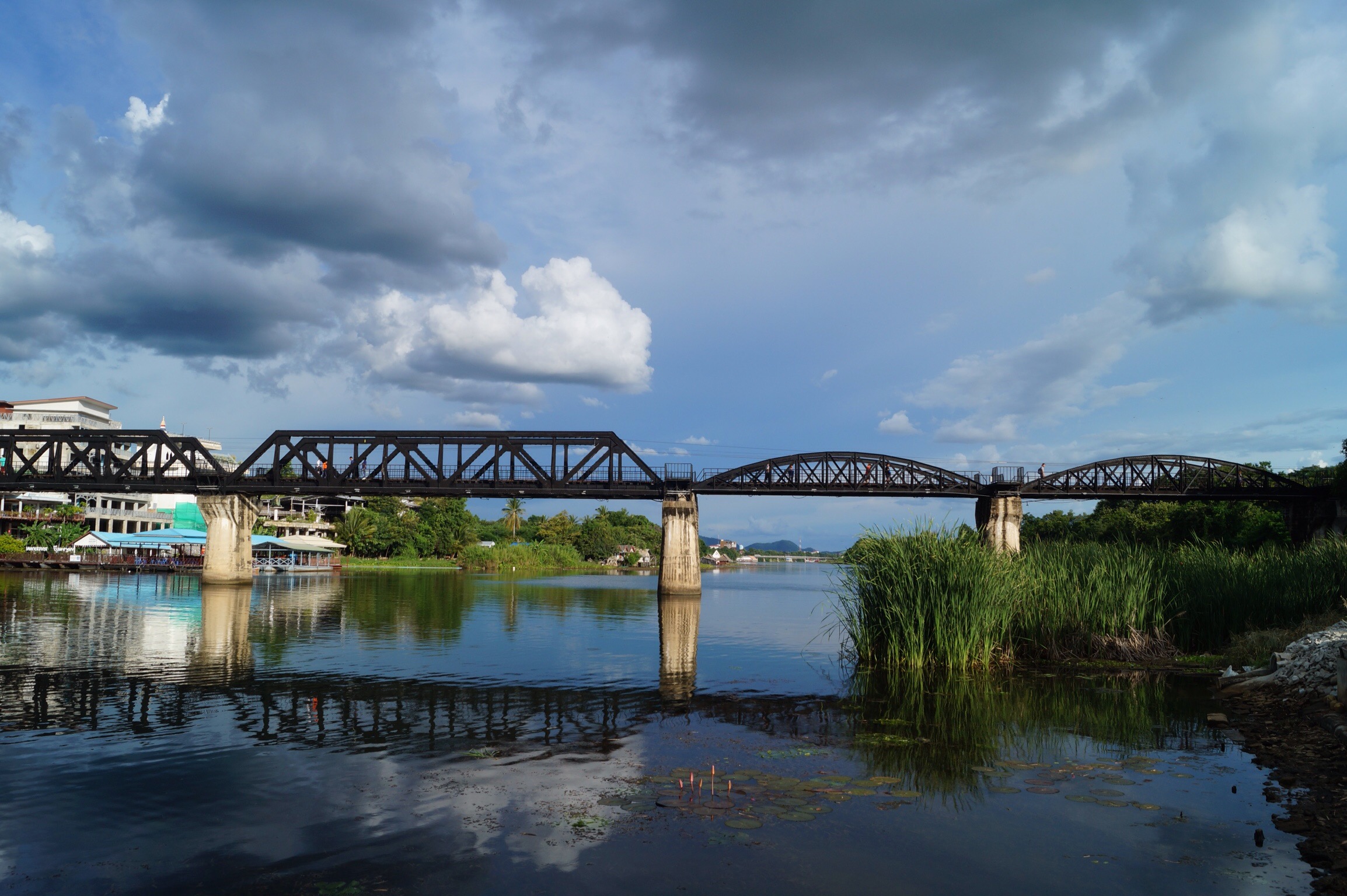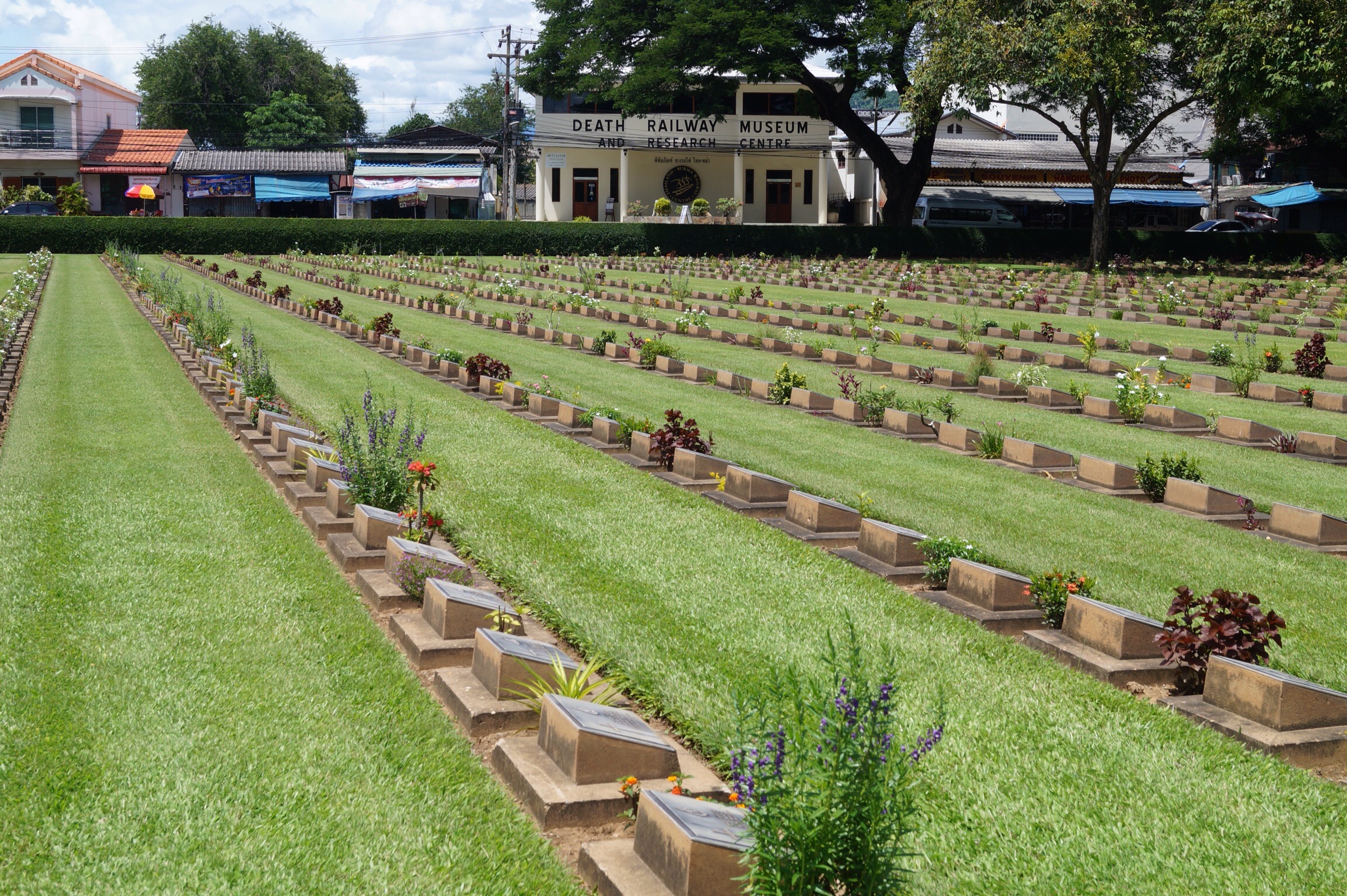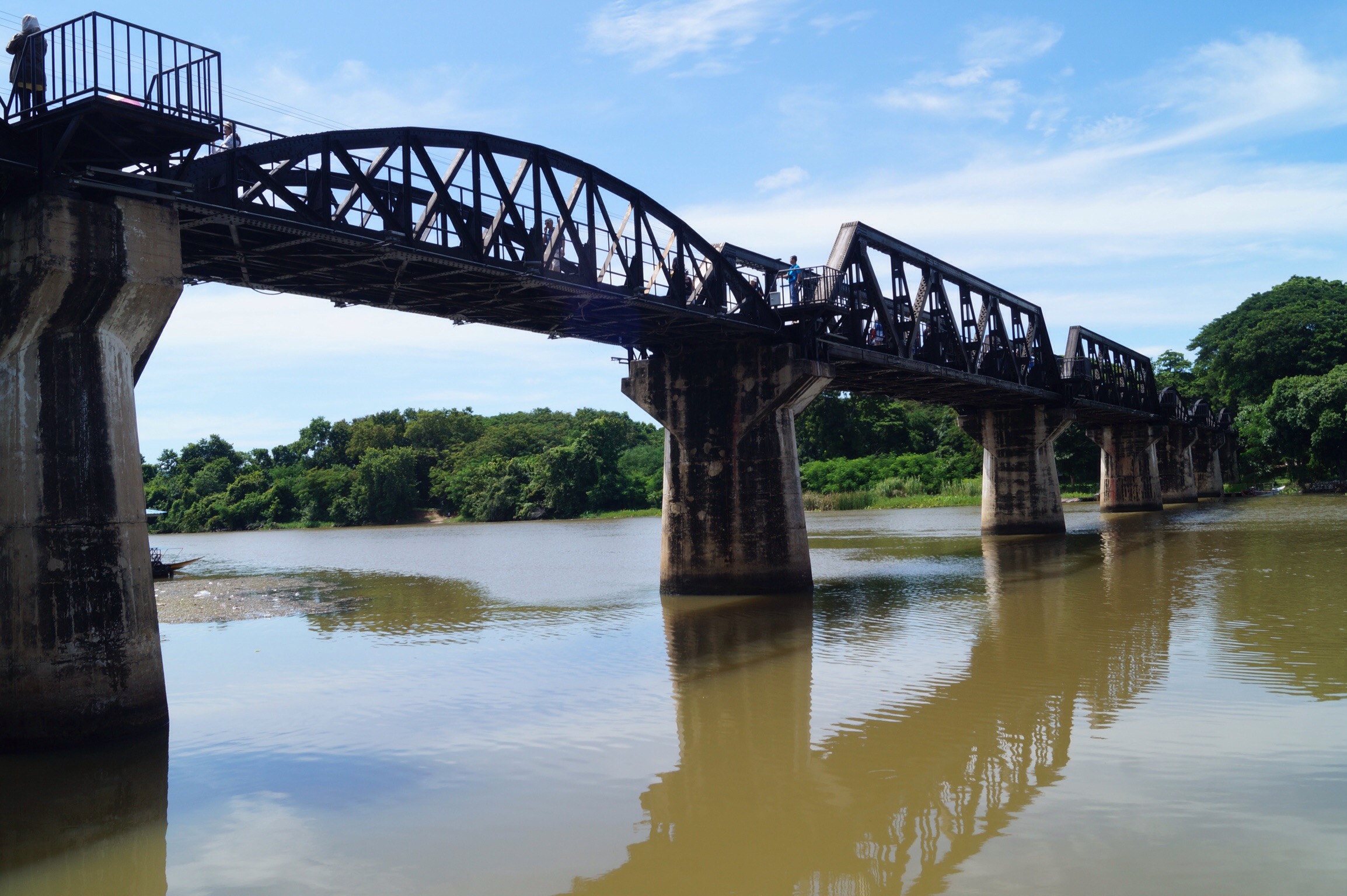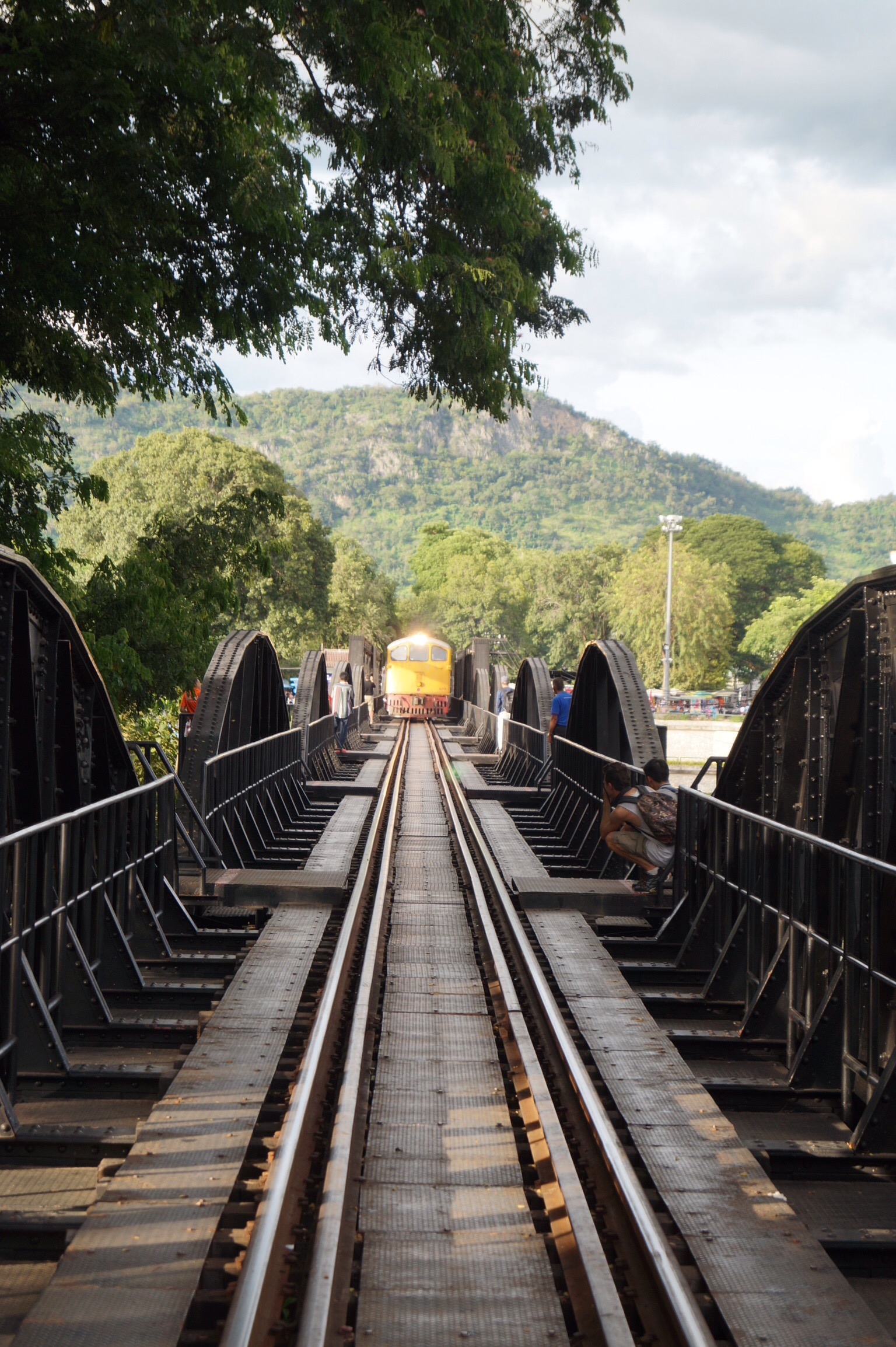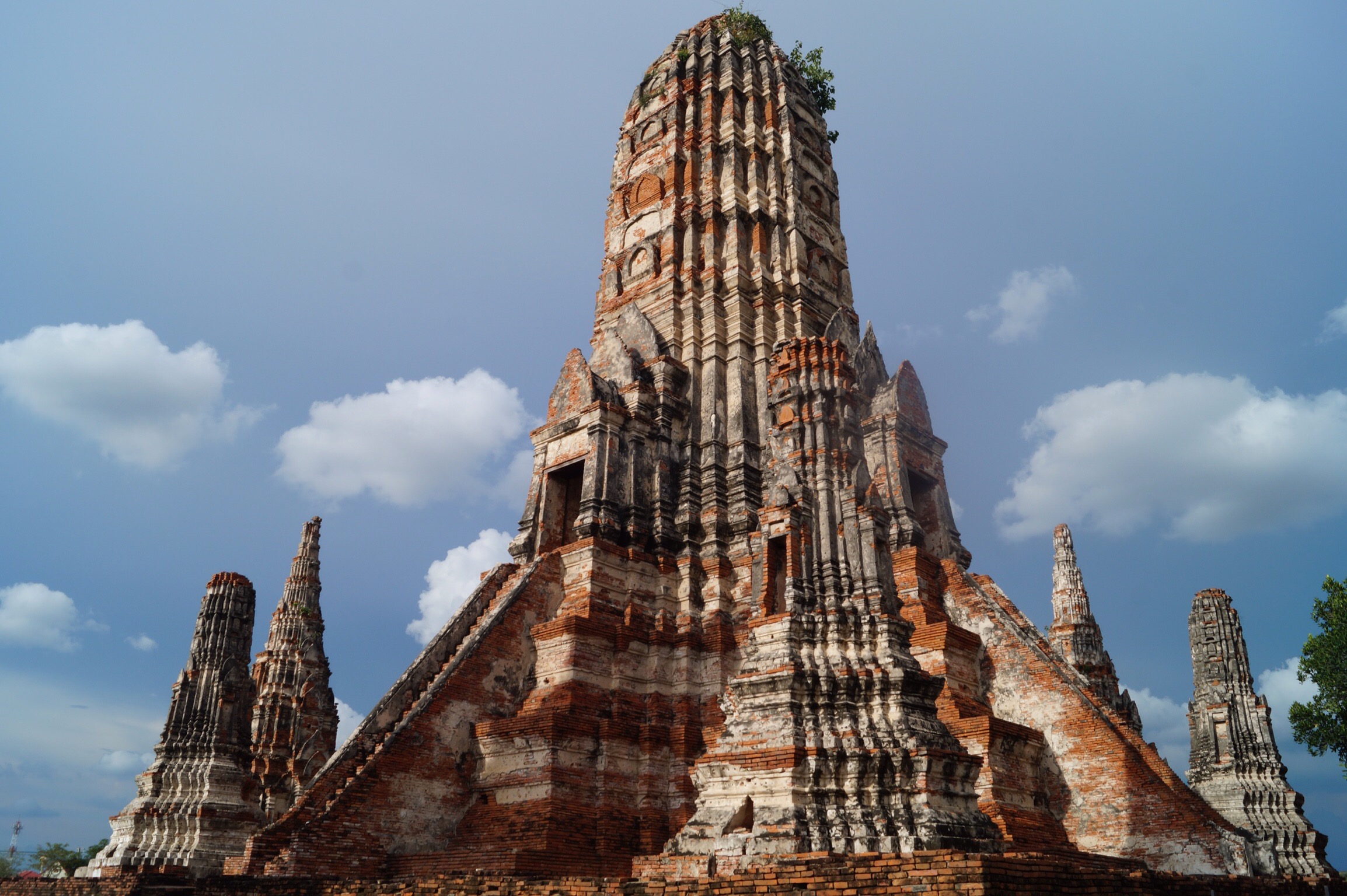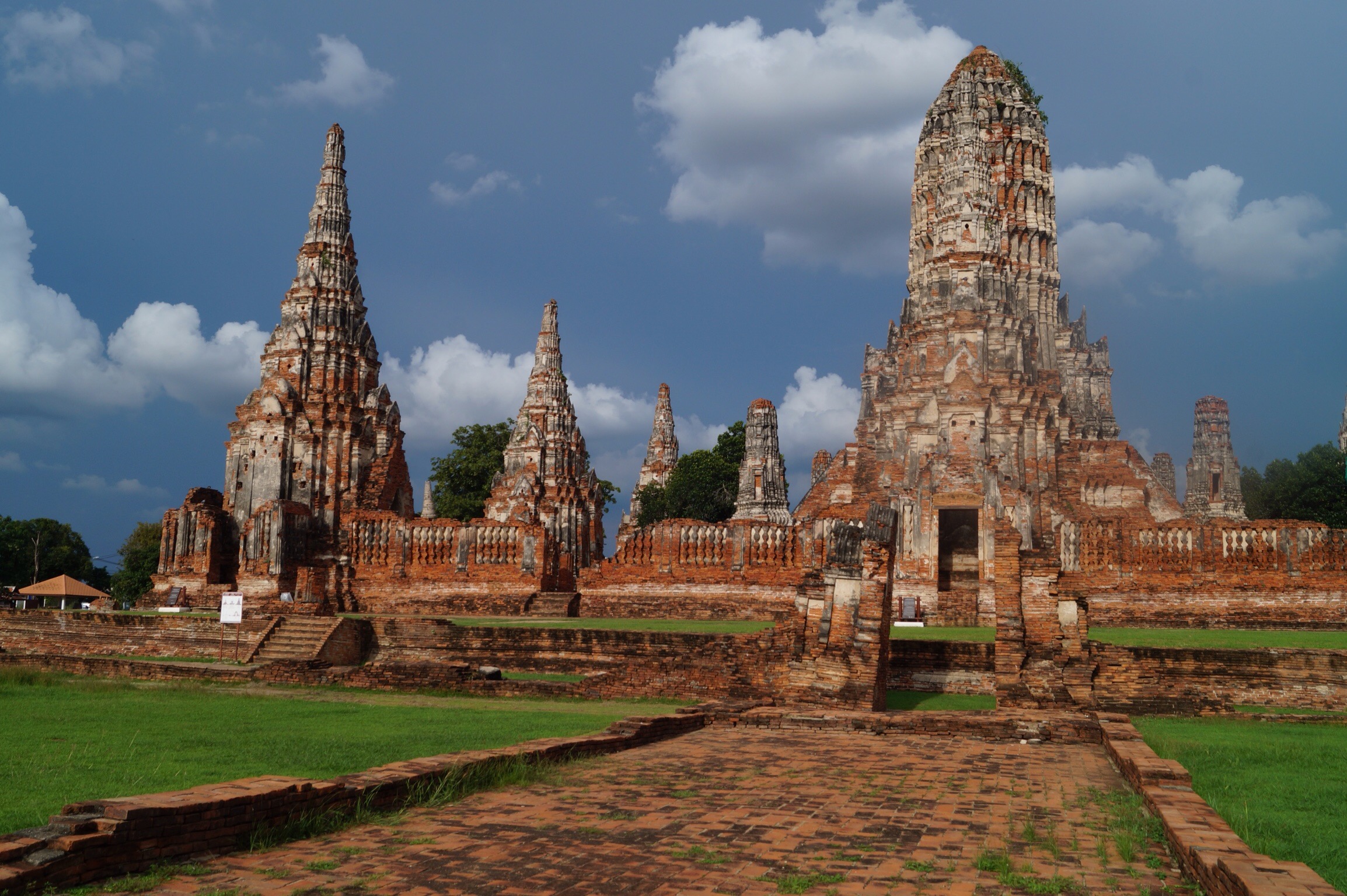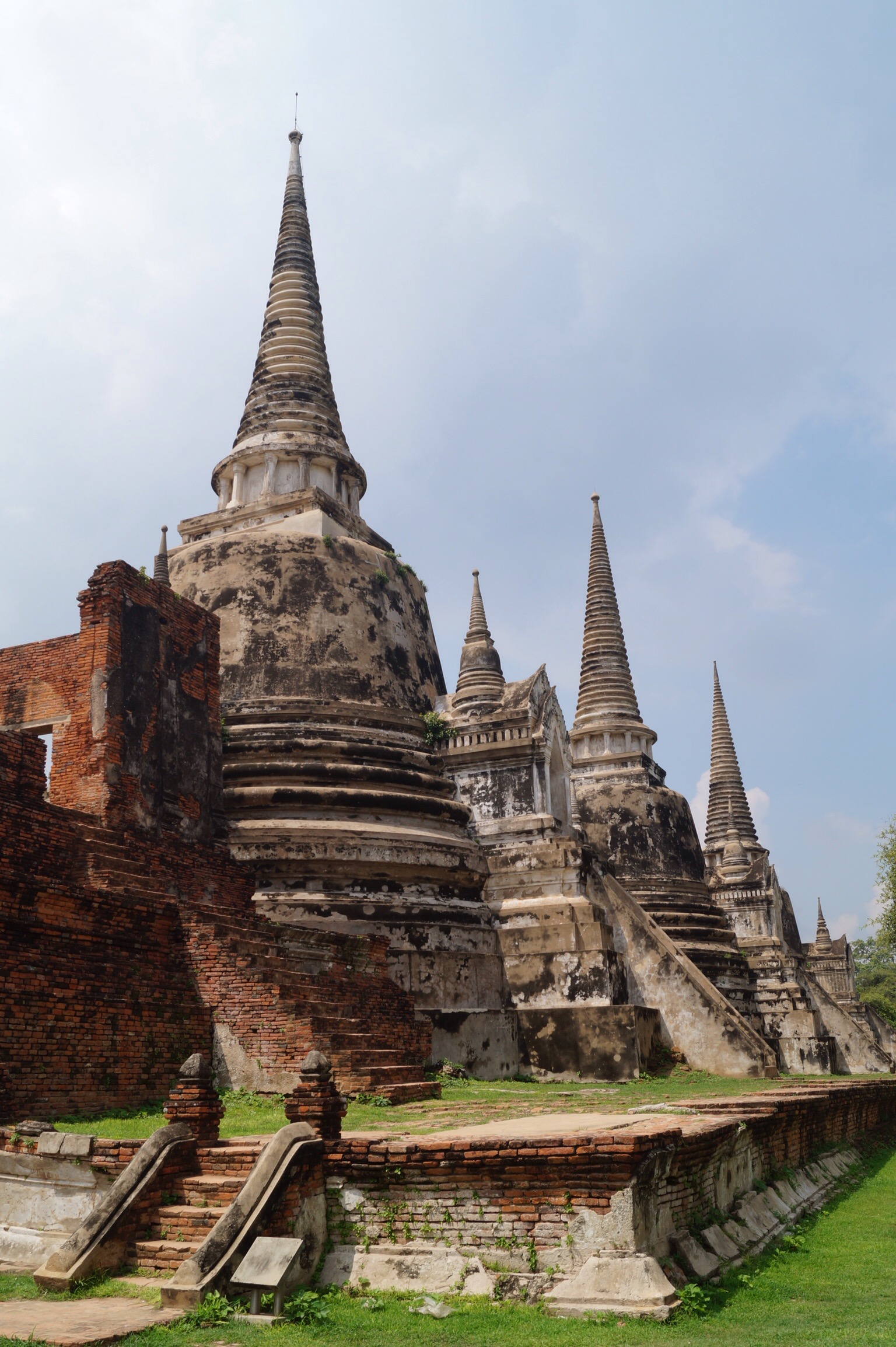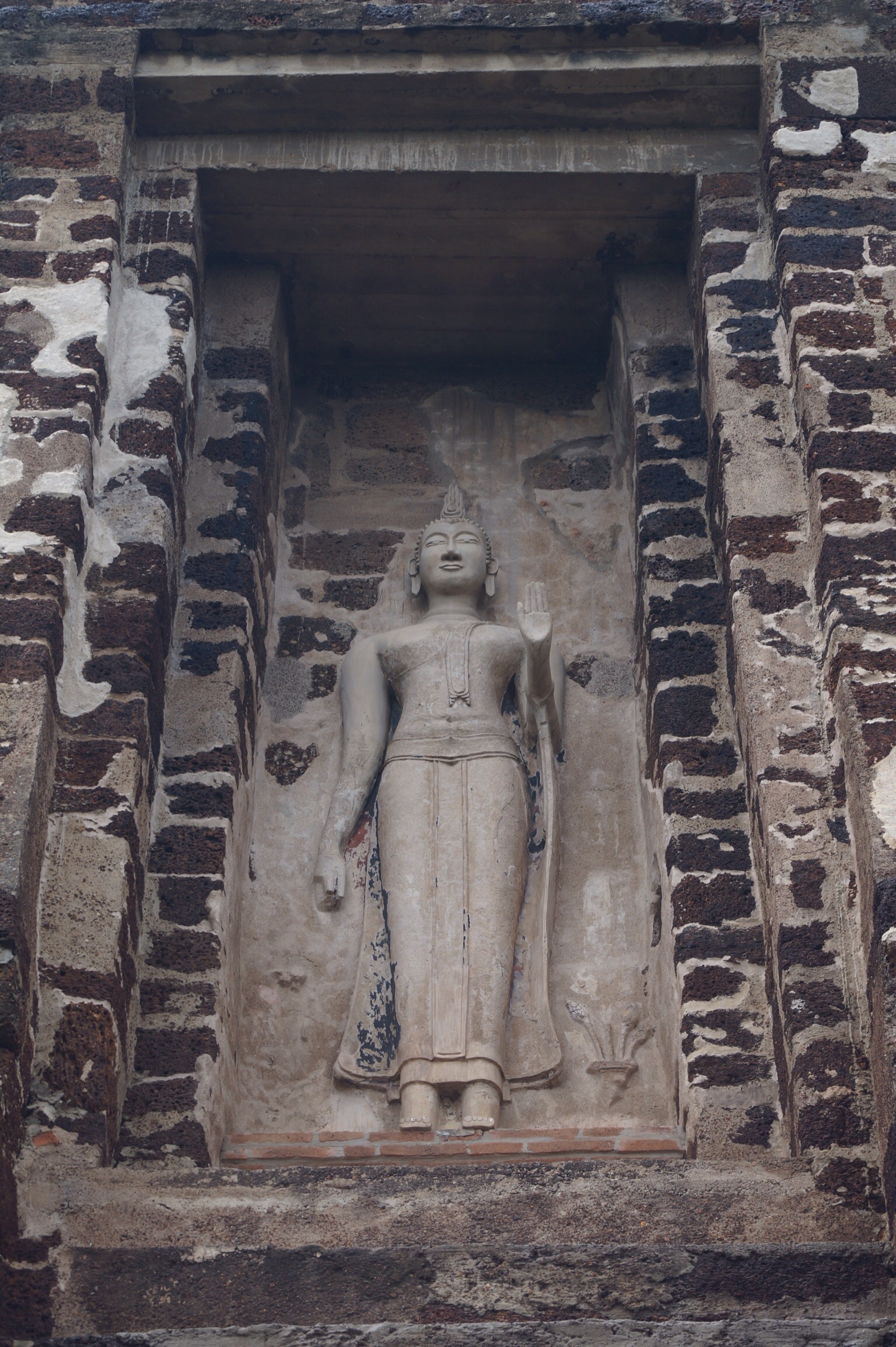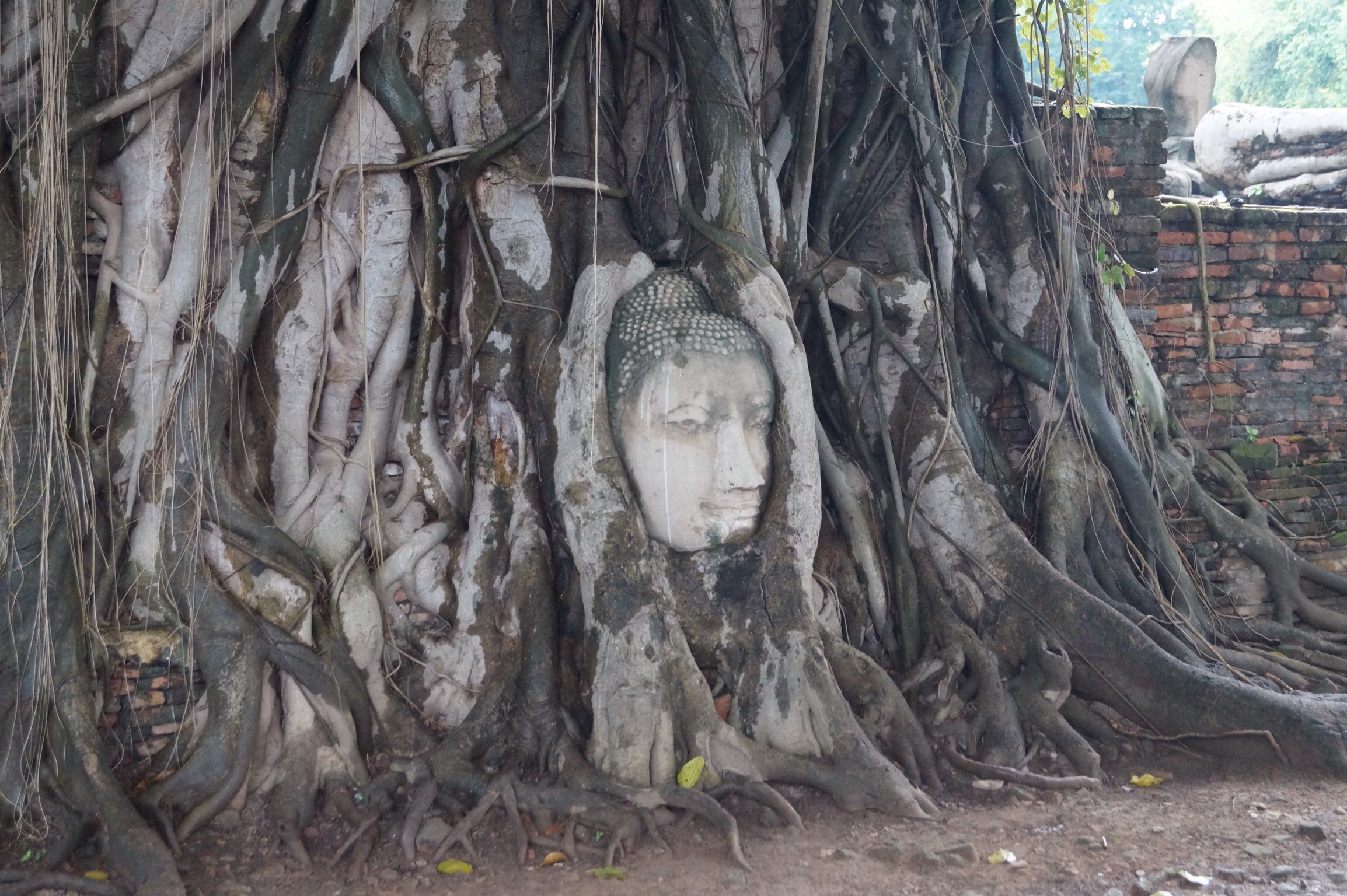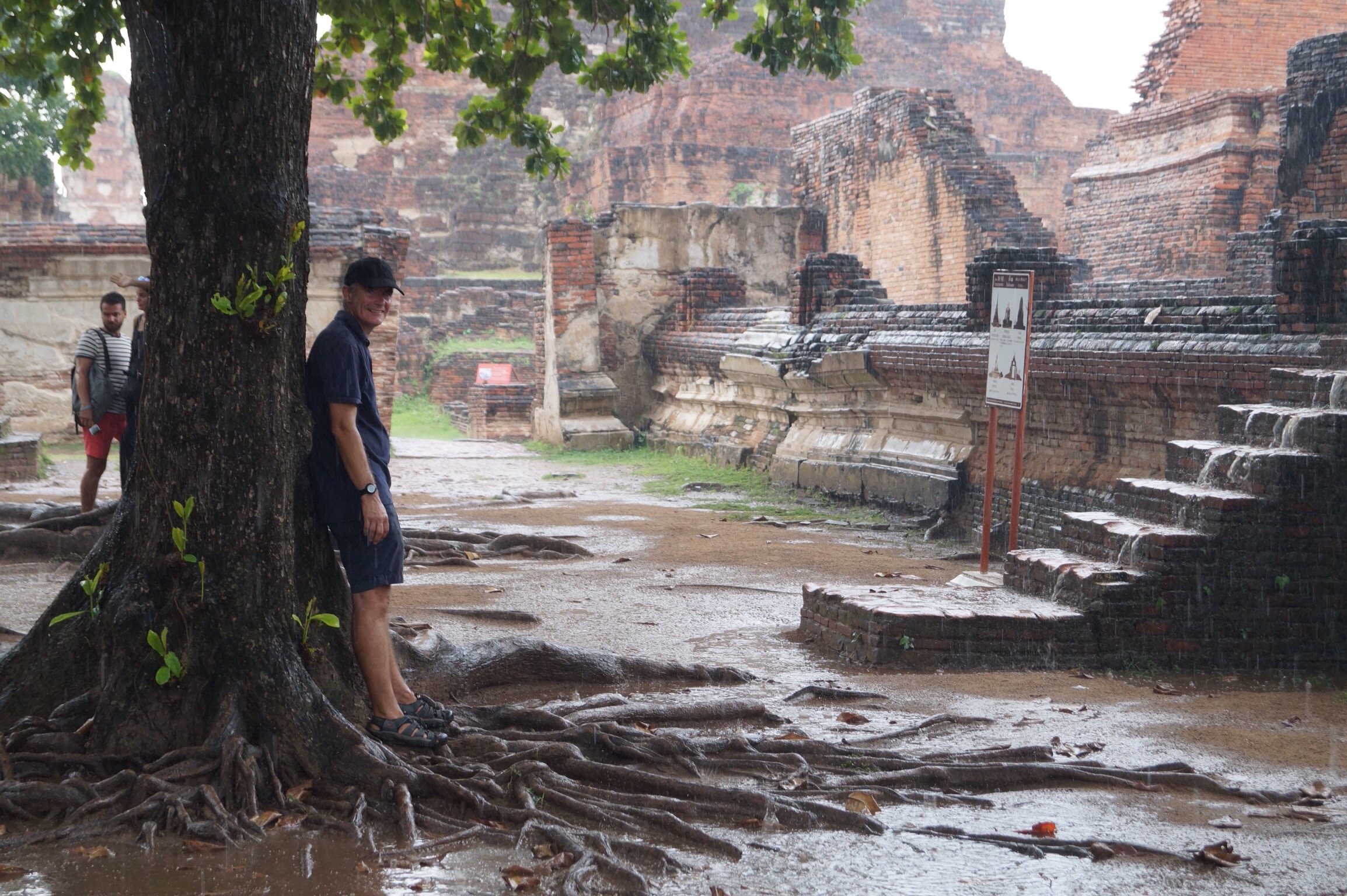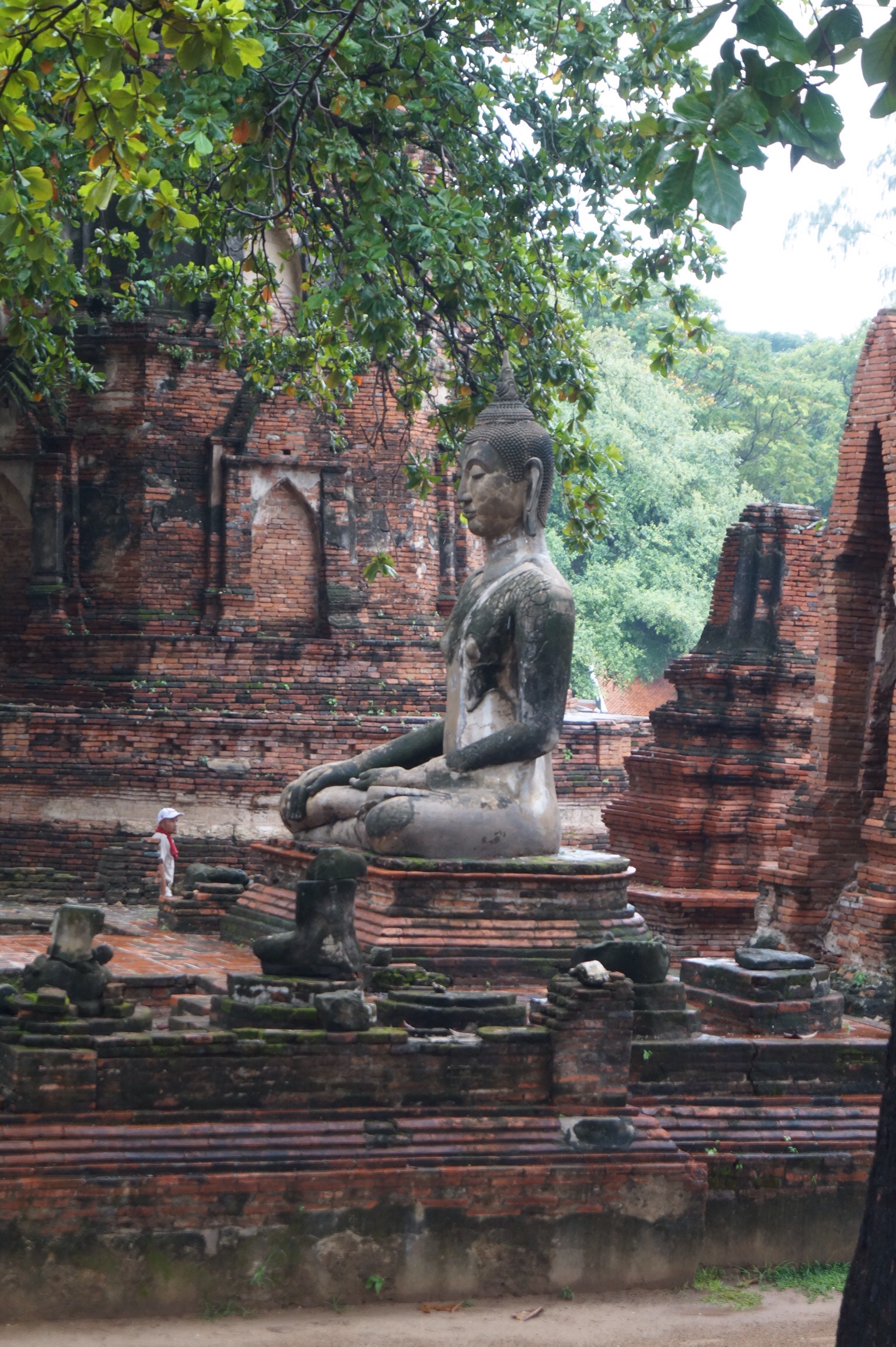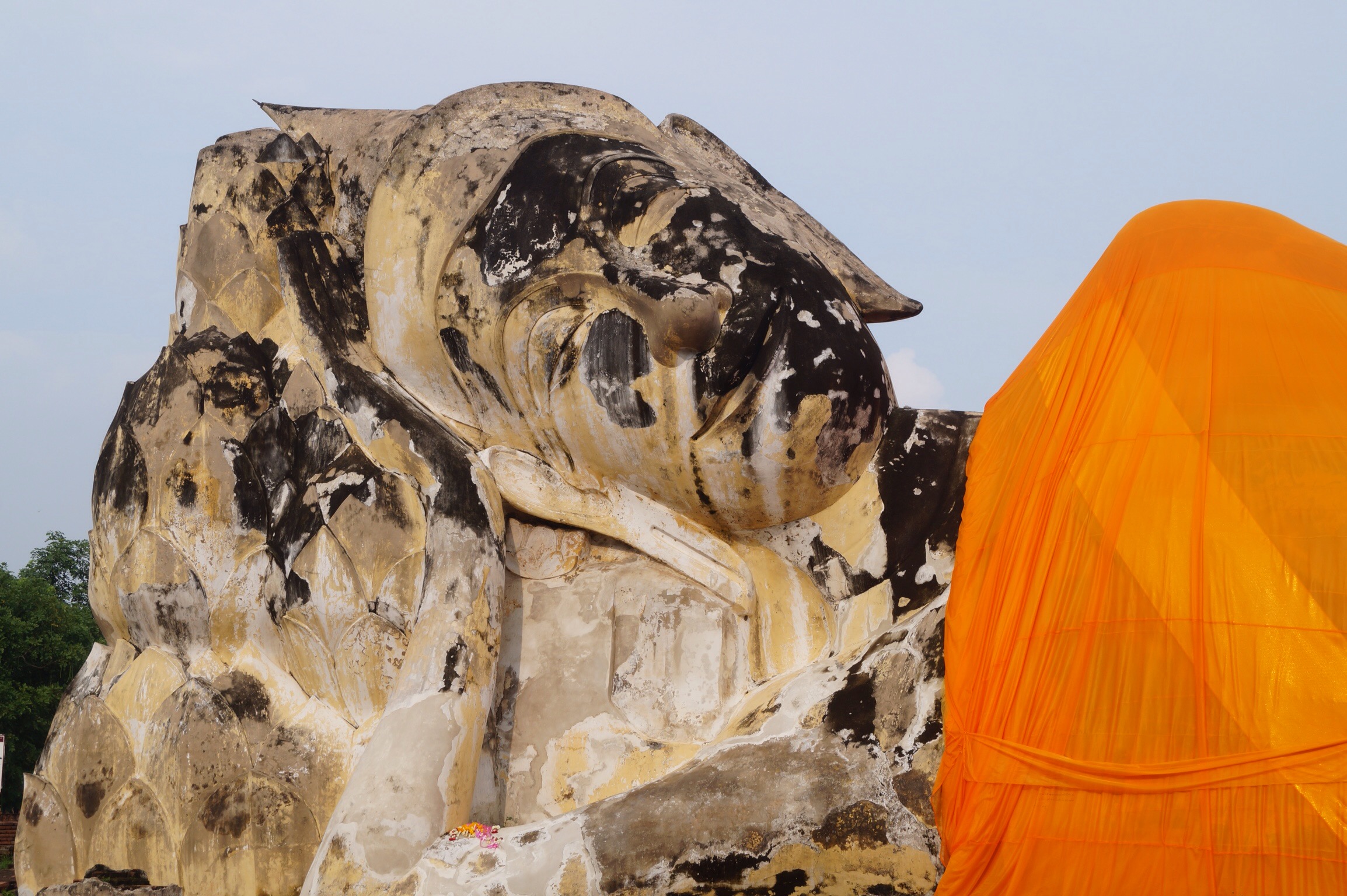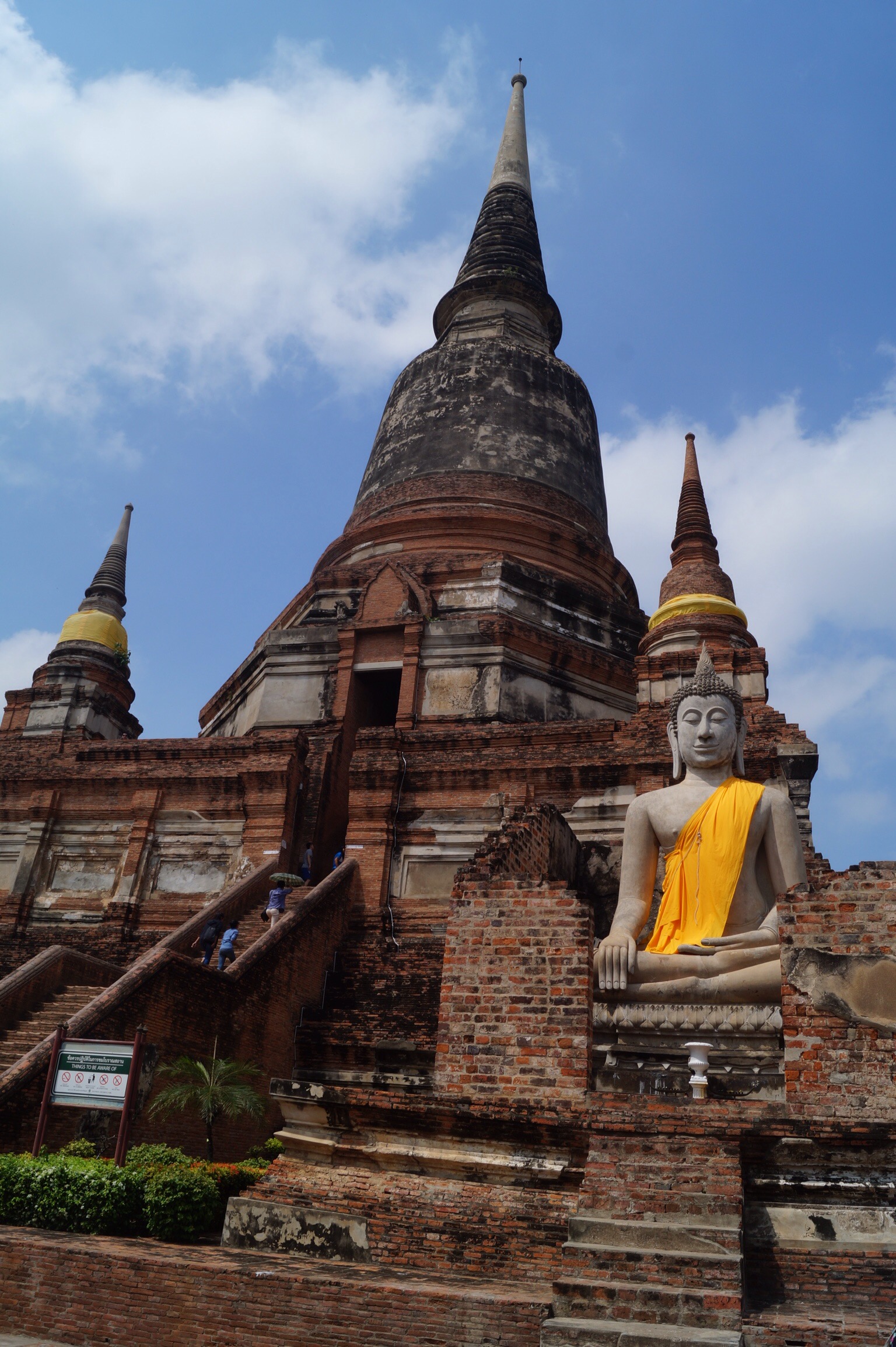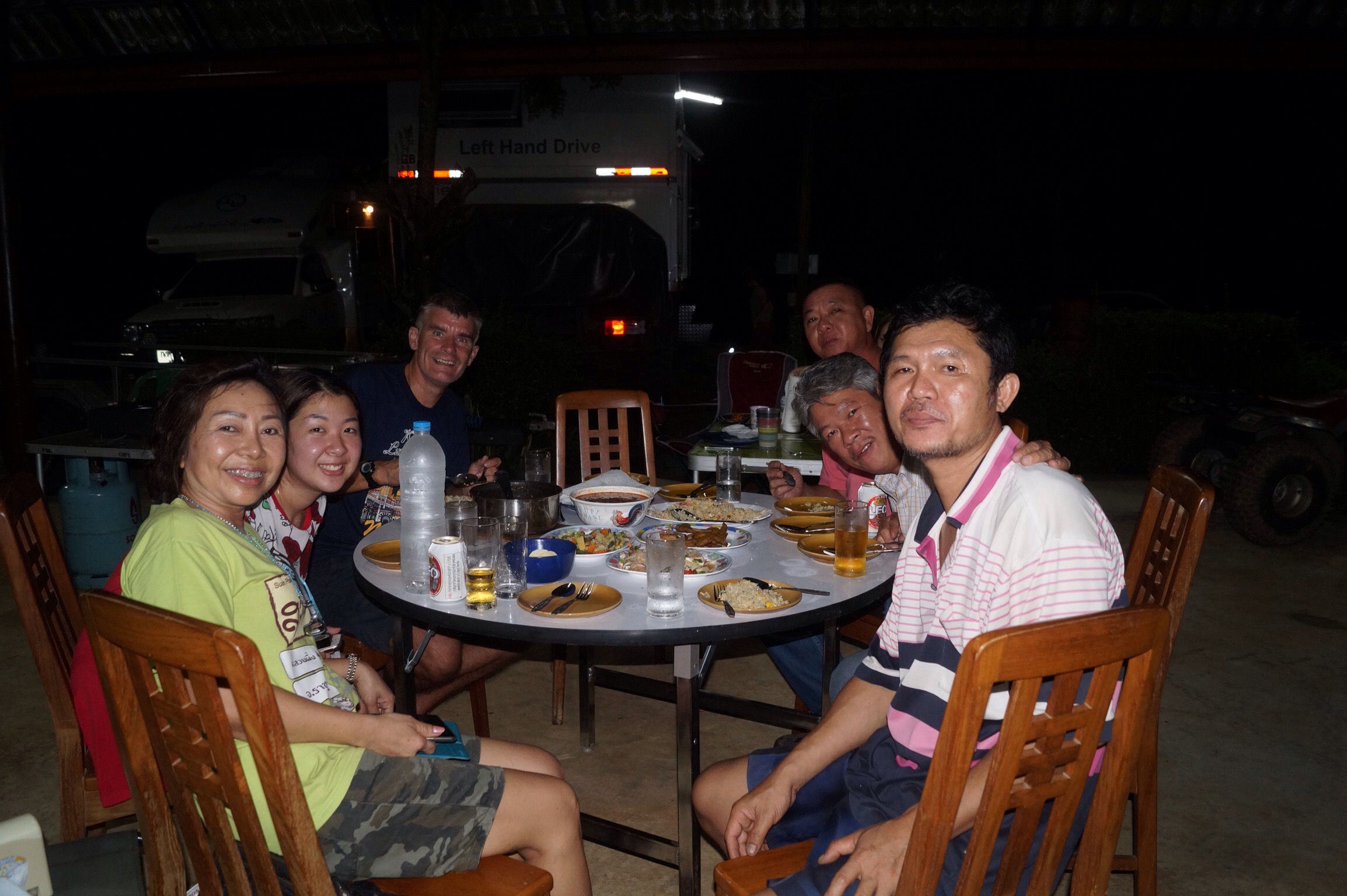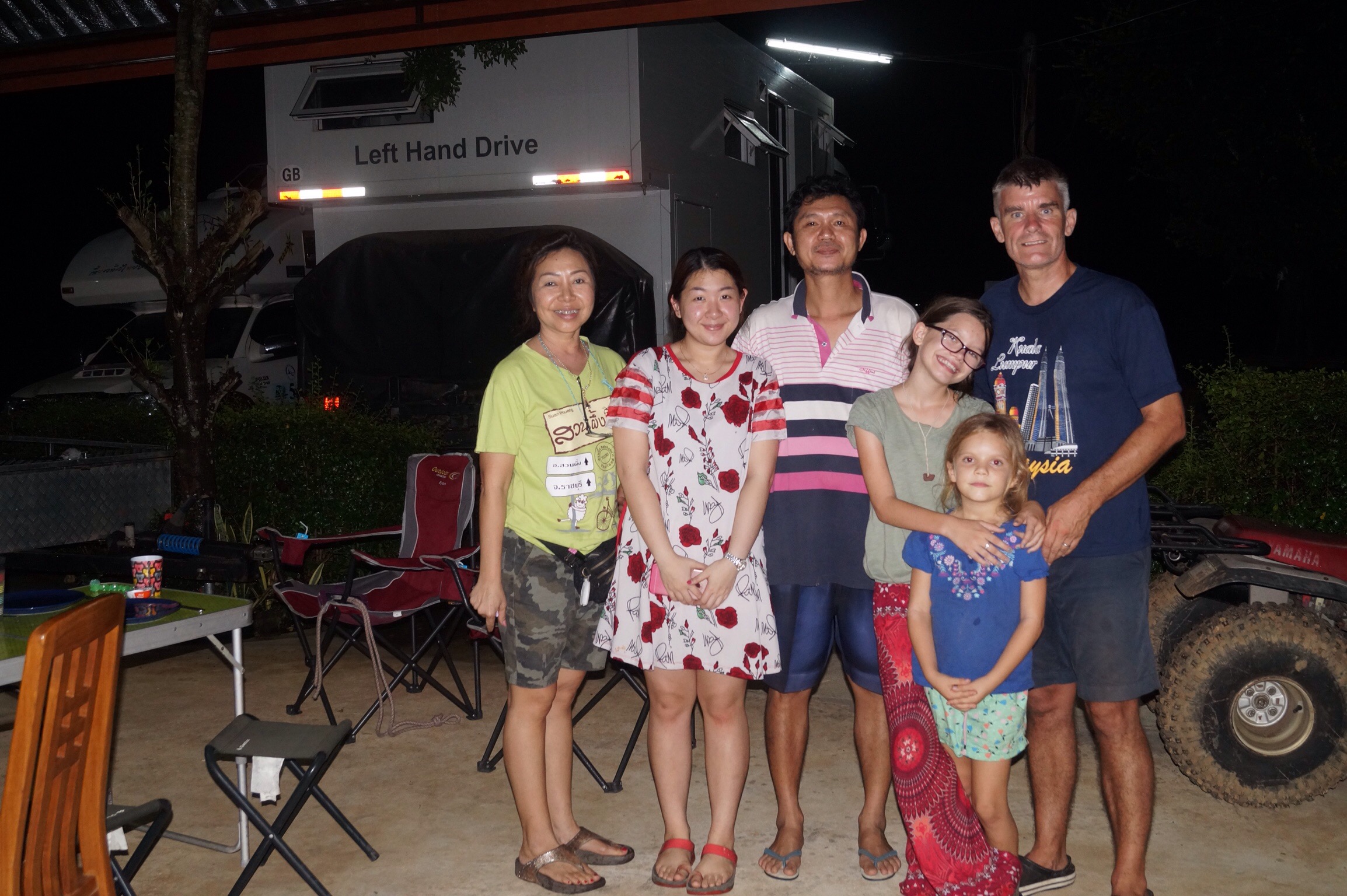The border post of Poipet, between Thailand and Cambodia, was a seething mass of people. It was a confusing place with huge handcarts bulging with goods being pushed across by bare chested men, every sinuous bicep straining at the effort. No-man's land was full of cars; trucks; buses; tuk tuks; whole families on motorbikes; gamblers visiting the casino between the two countries; migrant workers clutching sheaths of paperwork, young westerners with huge backpacks; and me clutching the sweaty hands of Alisha and Lucy. As the perspiration trickled down my back, we waited in the slight shade of an archway that was welcoming us to Cambodia, just hoping we were waiting in the right spot. My head was pounding and I felt feverish, it looked liked I had caught Steve's "man-flu" from the previous week. With just our passports in my pocket, nothing else, I scanned the distant gate exiting Thailand....There at last I saw the familiar square outline of the truck. What a relief! The girls jumped up and down to attract Steve's attention.
After the truck's paperwork had been completed to leave Thailand, with quite a bit of confusion as we seem to not have been issued with an important piece of paper when we entered we now had to separate for immigration, as only the driver could go through with the vehicle. They kept on insisting that the girls and I hurry through, as there were supposedly big queues. Unhappy about leaving Steve and the truck, I eventually capitulated after they had drawn us a map telling me where to wait. But we were so rushed though I didn't think to grab some money or go back to the truck for a phone. There was only one way through but still after checking out of one country, I wanted to make sure we could all get though to the next together. We hadn't seen this level of chaos at a border since Central America. To top off the confusion, halfway across no-man's land everything had to switch sides of the road as Cambodia drives on the right and Thailand on the left! At last we got through and realised the vehicular chaos continued on Cambodia's roads, with overladen motorbikes carrying huge sacks of grass or perhaps a couple of live pigs; tiny tractors with huge loads of heavy wooden furniture; trucks; and SUVs all going different speeds on the single lane national highway. I could see that the driving here was going to be "interesting".
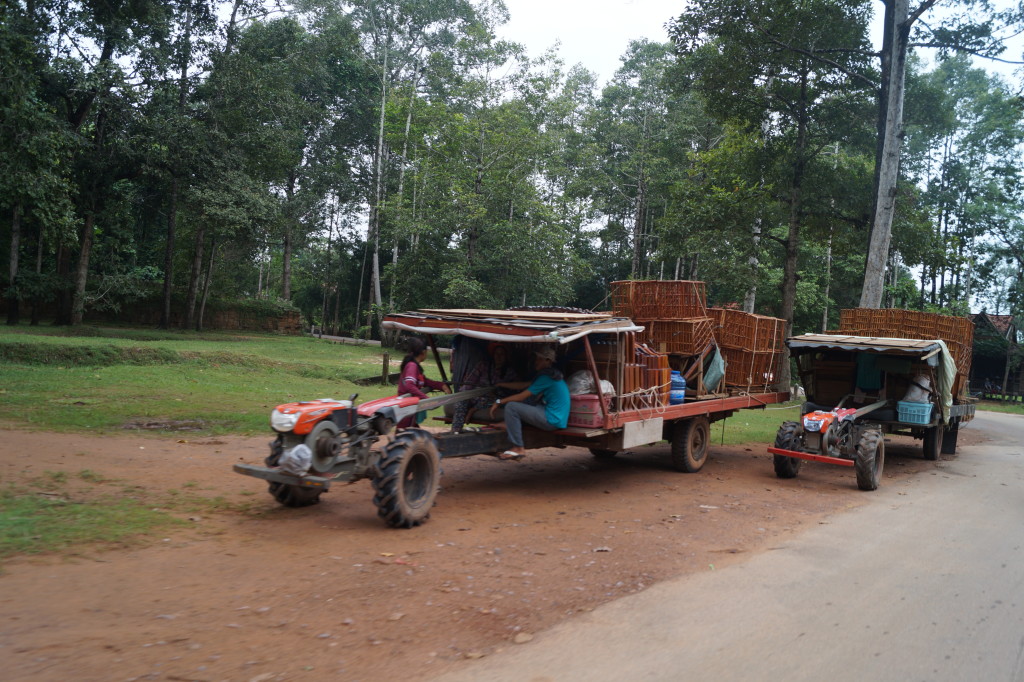
Arriving in the town of Siem Reap, all I wanted was to lie down in air-conditioning. Siem Reap is a few kilometres from the amazing UNESCO recognised ancient temples of Angkor Wat. Stretched out over many kilometres, they are all that is left of the mighty Khmer Empire that ruled the region between 802-1432 AD. We had already decided to spend a week in the area checking out some of the less visited temples as well as those at Angkor Wat and Angkor Thom. This turned out to be a great plan as it gave us lots of time for us all to get over being poorly and for Lucy to celebrate her 8th birthday.
Lucy will have been travelling for over half her life once we get home and this is her 4th birthday on the road. She has celebrated on the Big Sur in California; watching Jaguars in the Pantanal in Brazil; high up in the mountains of Lesotho and now in Cambodia. To be honest when you are 8, ancient temples are only so interesting up to a point. What you are really interested in on your birthday is toys and cake, so we skipped the sightseeing, relaxed at the hotel while she played with her few new toys, then explored town finding some very fancy birthday cupcakes at a bakery that trains vulnerable young women.
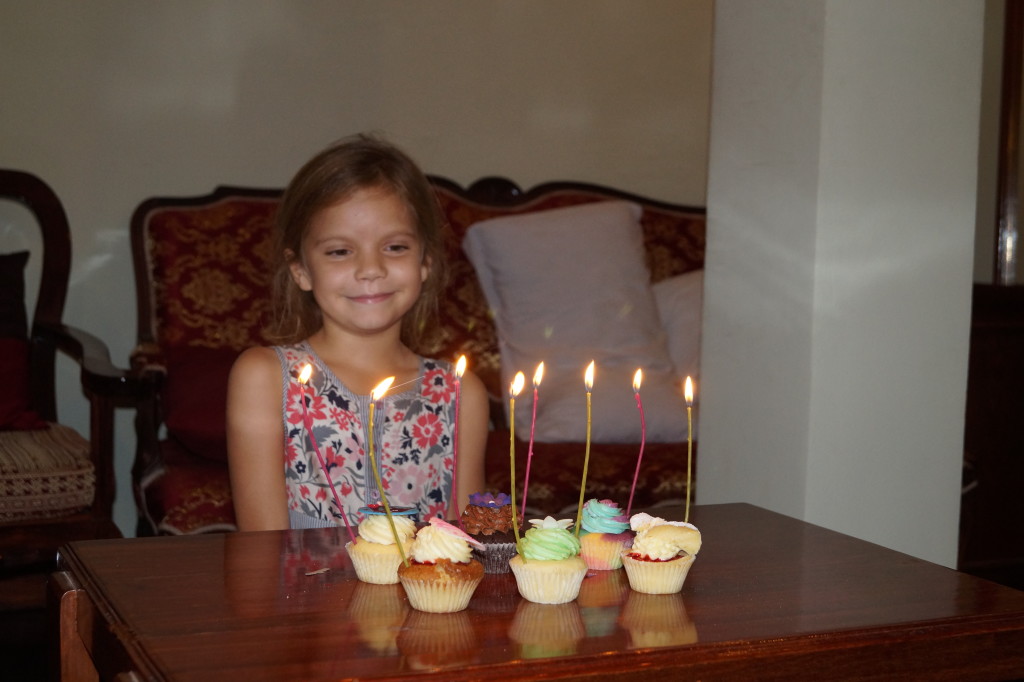
We started our temple exploration at some of the further out sites building up to the more famous ones. Jungles are wet dripping places, earthy smelling and greenly fecund. You can still see the evidence of how the jungle hid the temples for many centuries with huge buttress rooted trees balancing precariously on top of temple roofs and long sinuous roots twisting around green mossy walls, like boa constrictors. Many of the temples have been cleared of the worst of the jungle, keeping the foliage at bay is the task for green-clad workers armed only with old fashioned scythes. We explored the maze of tall stupas, tumbled down walkways covered in mosses and lichens; exquisitely carved prayer halls and dark tunnels smelling of the heady mixture of incense and bats. There was a beautiful gem in almost every corner, just begging to be photographed. The girls had studied the different carvings of creatures from Hindu and Buddhist mythology earlier in school. So while Steve and I played "Indiana Jones" imagining ourselves hacking our way through the jungle, the girls called out: Apsara - heavenly nymph; Rishi - Hindu holy man, seven headed Naga snake; Kala - temple guardian who ate his own body ..... Bingo!
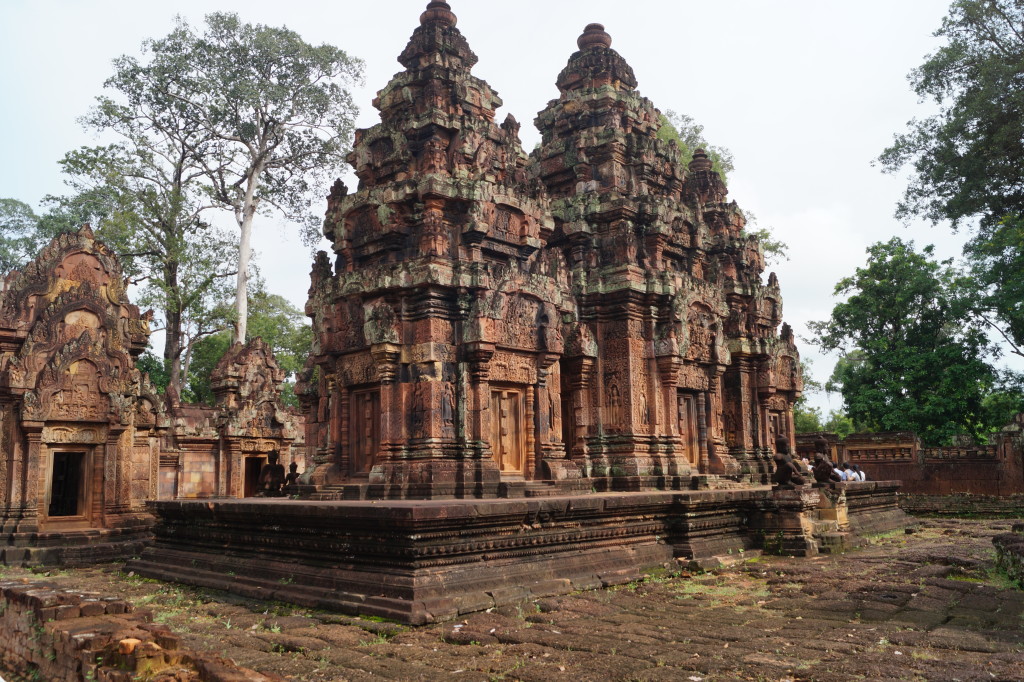
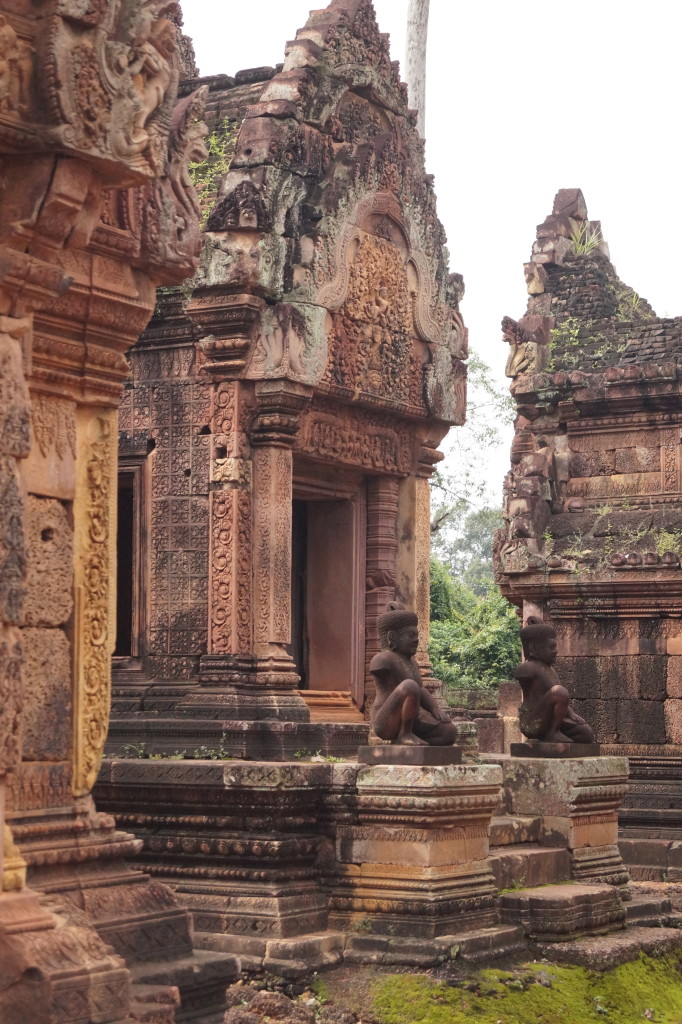
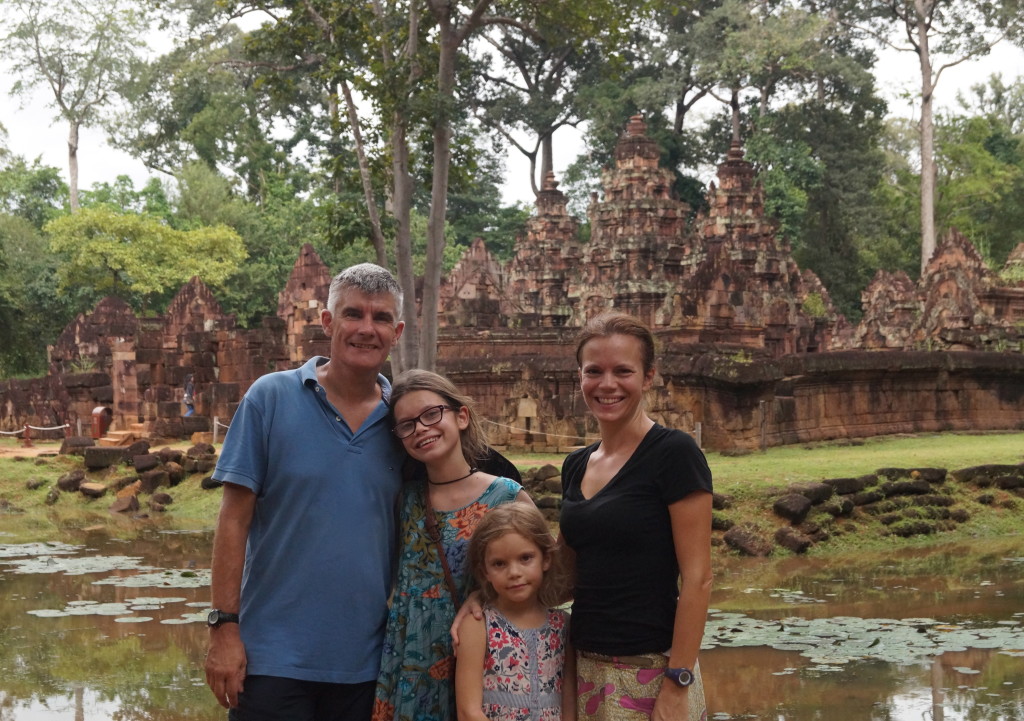
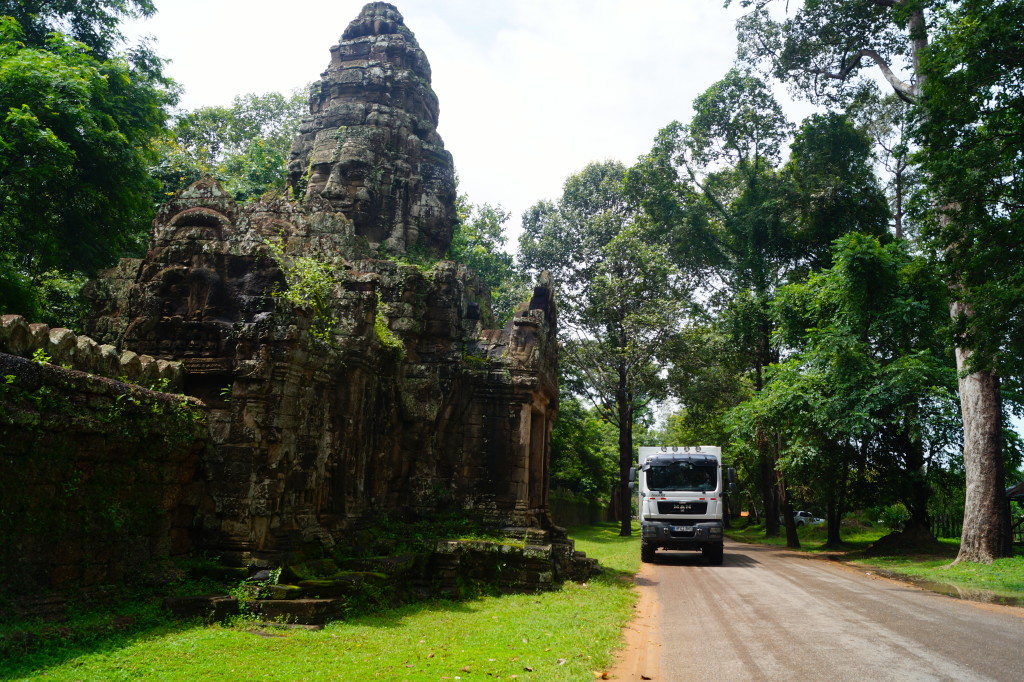
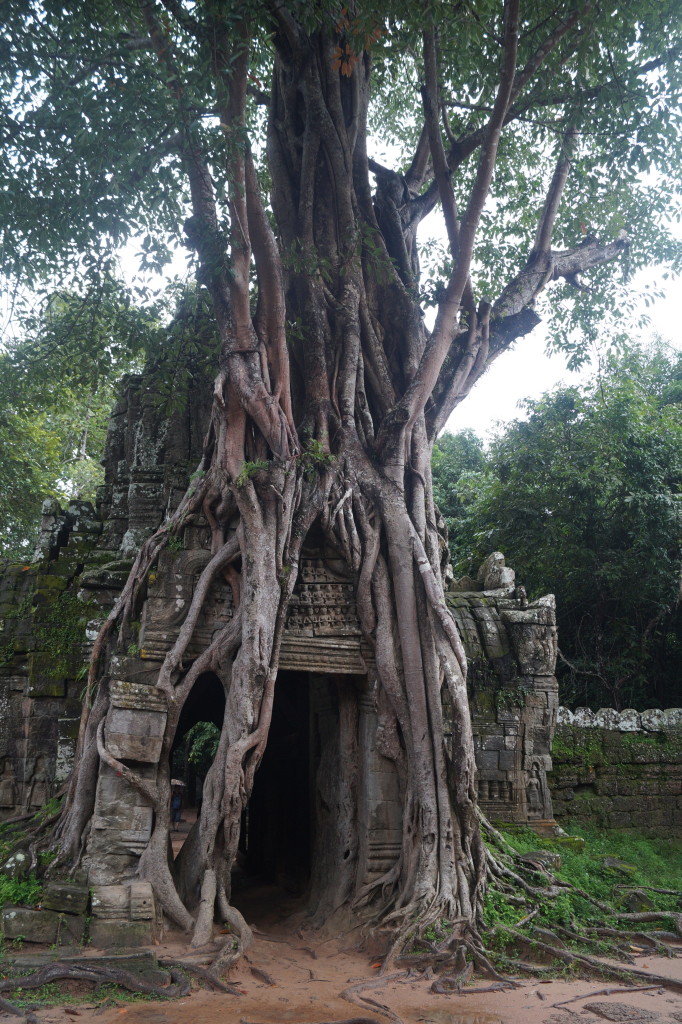
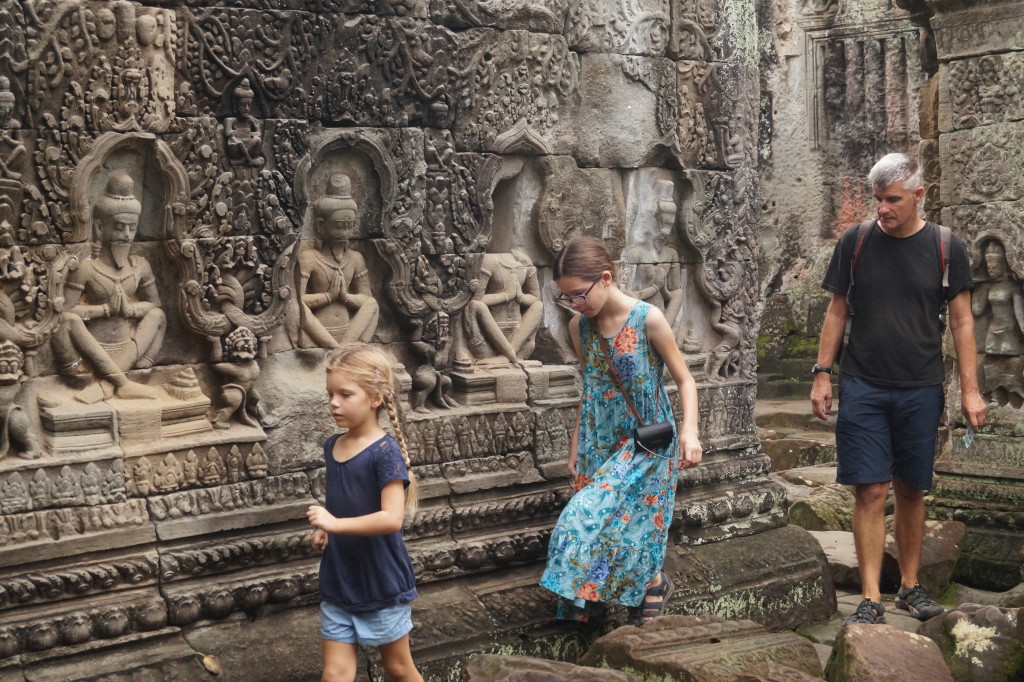
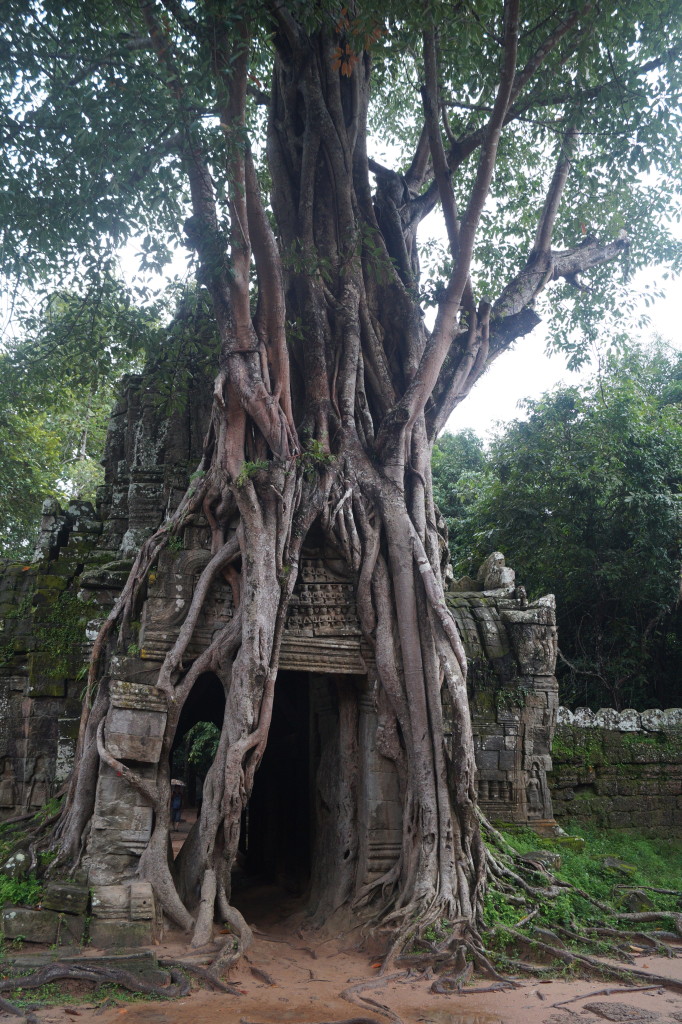
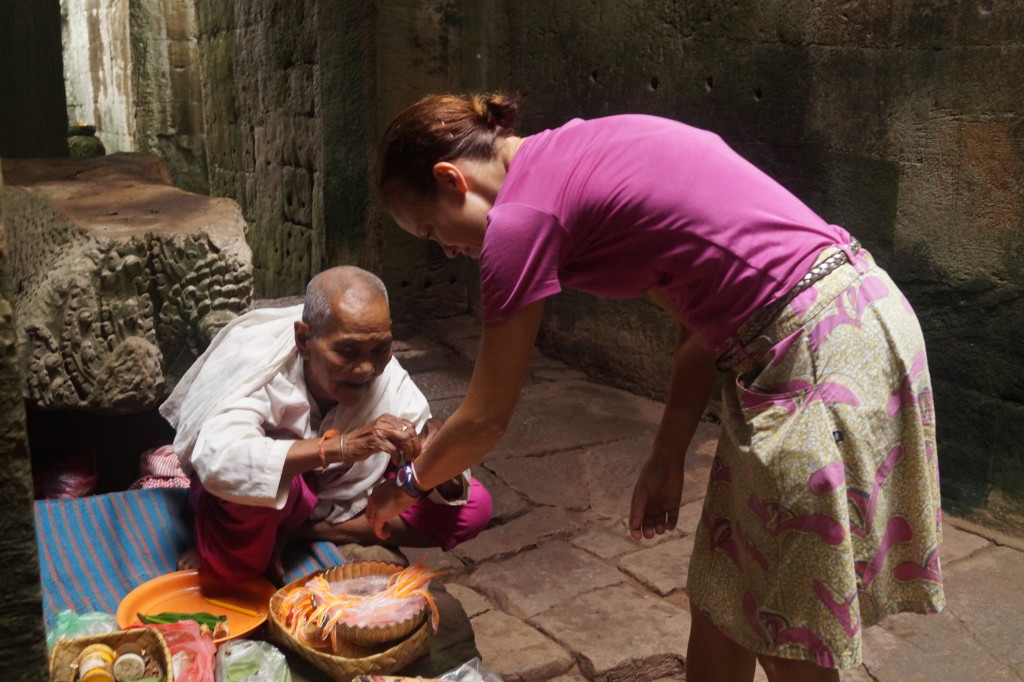
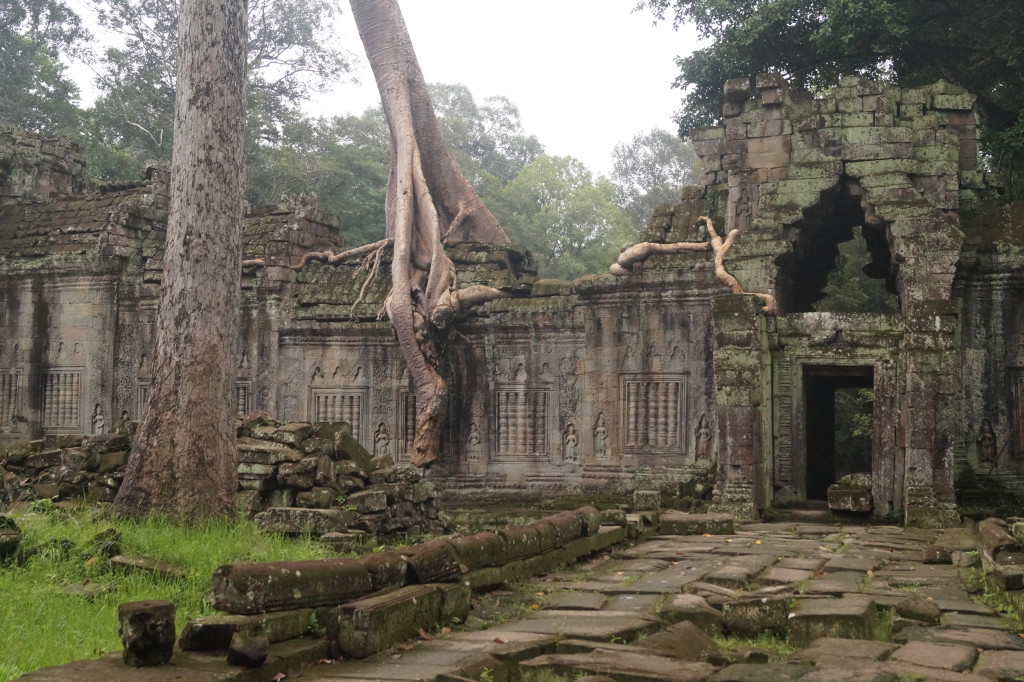
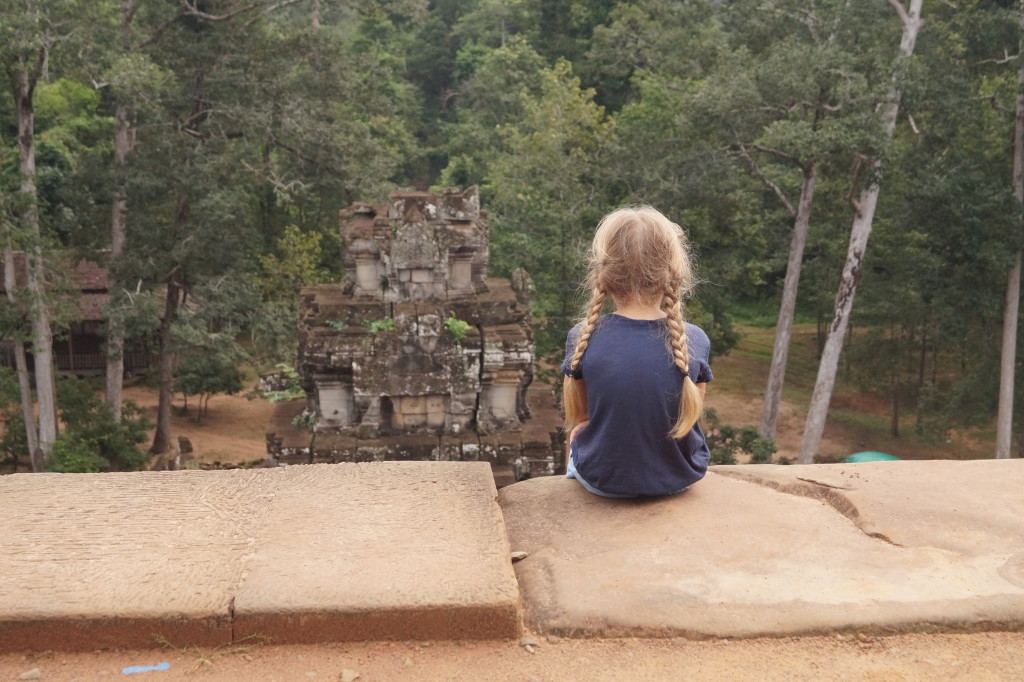
Not wanting to be thought of as "soft" hotel dwellers for too long we moved back to the truck for a few nights. The accommodating Tourist Police on the road out to the temple allow overlanders to park at their station, to discourage people from staying outside the temples. Unfortunately we were too tall to fit under their entry gate, "Don't worry," they said just park outside in the disused ticket office lay-by. Perfect we though, it might be a carpark but it was quiet and the concrete underneath was solid. There had been lots of torrential monsoon-type deluges during our time in Siem Reap and the ground was sodden, we had seen several vehicles stuck in up to their axles in mud, so we were keen to stay on the tar. So we sat smugly inside that night listening to the frogs sing and the rain thundering down, enjoying the slight dip in temperature.
After one of the rainstorms when we were parked at the hotel.
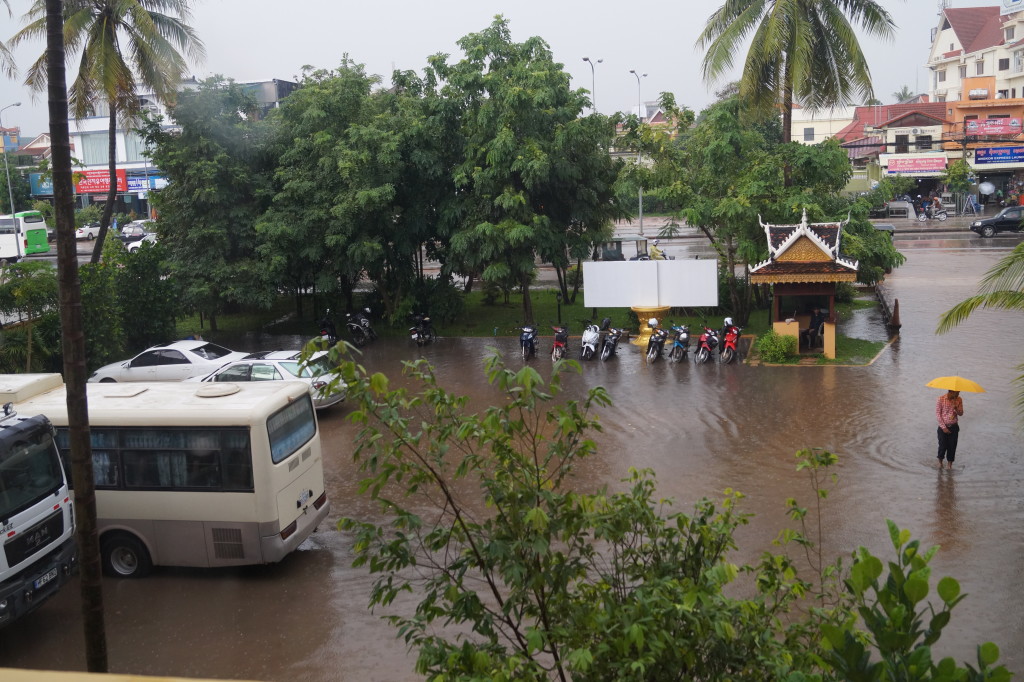
It was just after 4.30am when we heard the first roar of an overworked tuk tuk engine, whizzing past a metre from the back of the truck's open windows. Like the sound of the annoying mosquito, I only partially gained consciousness rolled over and went back to sleep. Then the noise came again and again and again until I couldn't ignore it anymore, just what was going on outside. Looking out we realised that although the ticket office was no longer being used, every single vehicle visiting the temples had to pass through the lay-by to get their ticket checked. Maybe not such a great parking spot after all. Sod it, if you can't beat them- join them, was the decision. So up we got to drive the 5km to Angkor Wat to hopefully see the sunrise over the magnificent rooftop. Although the road was quiet by Cambodian standards and dead straight, driving in the pitch black was a challenge. Tuk tuks without lights whizzed in and out of potholes; we nearly ran into the back of a tractor and crazy backpackers doing stupid things on motorbikes and bikes. My least favourite was when we came across 4 bicycles holding onto the back of a motorbike taking up the whole of the road, none of which had any lights. It's no wonder there is a huge international hospital, as well as the local ones in Siem Reap.
Once safely at Angkor, having successfully not killed anyone else or ourselves on the road, we headed into the temple complex to watch sunrise. A pinnacle of many people's trip to South-East Asia, watching the soft morning glow of the sun rising above the spires of Angkor as the myriad of colours are reflected in the symmetrical pools is magical. Or not in this case. The rainy seasons omnipresent clouds meant that we watched a very grey looking Angkor Wat, slowly get lighter before it started drizzling. Oh well, there is always tomorrow. Off we set early again and three days after that - still no luck. We moved into a hotel for the intervening night, just so we could all have a lie in.
Using the camera's maximum "sunset" setting for sunrise over Angkor Wat.
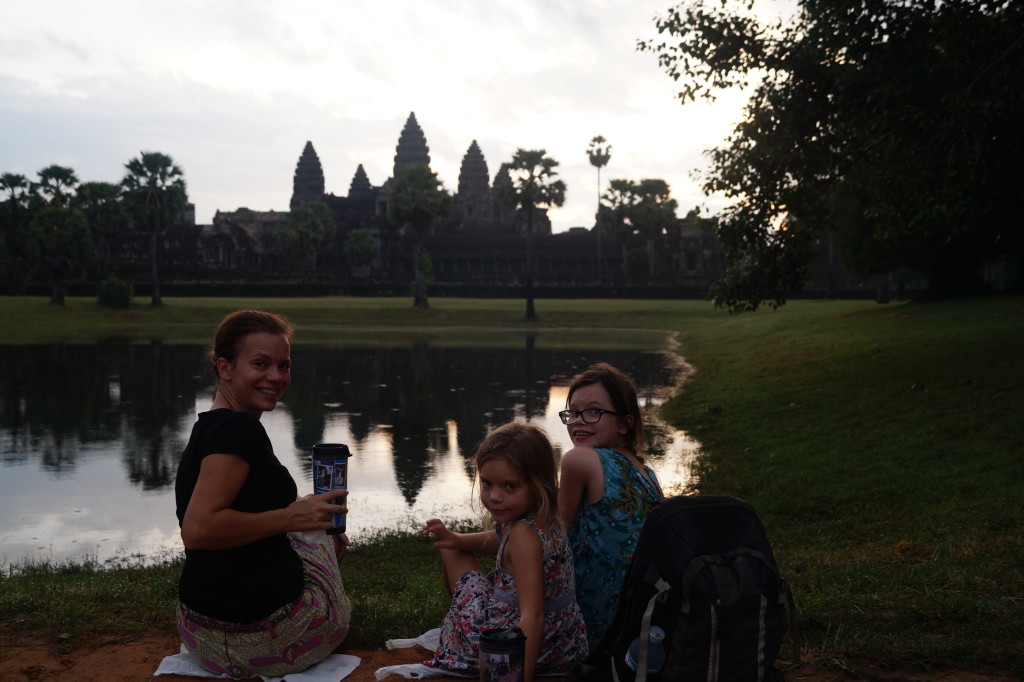
Despite our damp slight disappointment of the mornings, we loved the beauty of the main temple of Angkor Wat. The outside chambers are covered in exquisitely complex carved frescos, telling of epic battles and stories. The temples inside gradually get higher and higher and now you can climb up inside the highest spire to look out on the green paddy fields and jungle around you. It's a magical place. We went back a few times during the days to explore the further corners of the world's largest religious building.
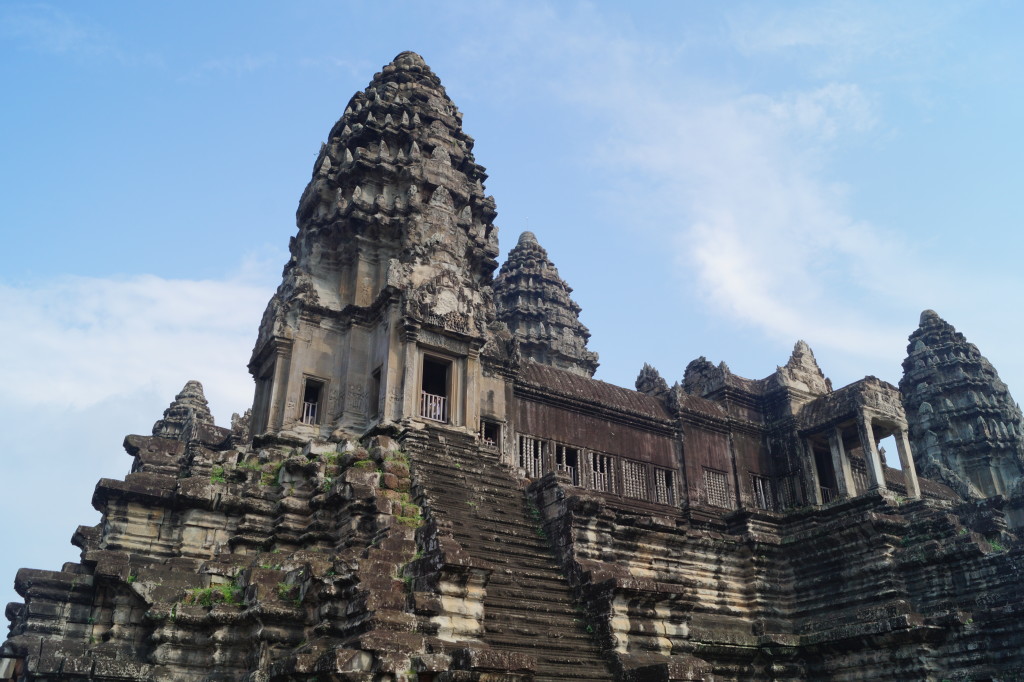
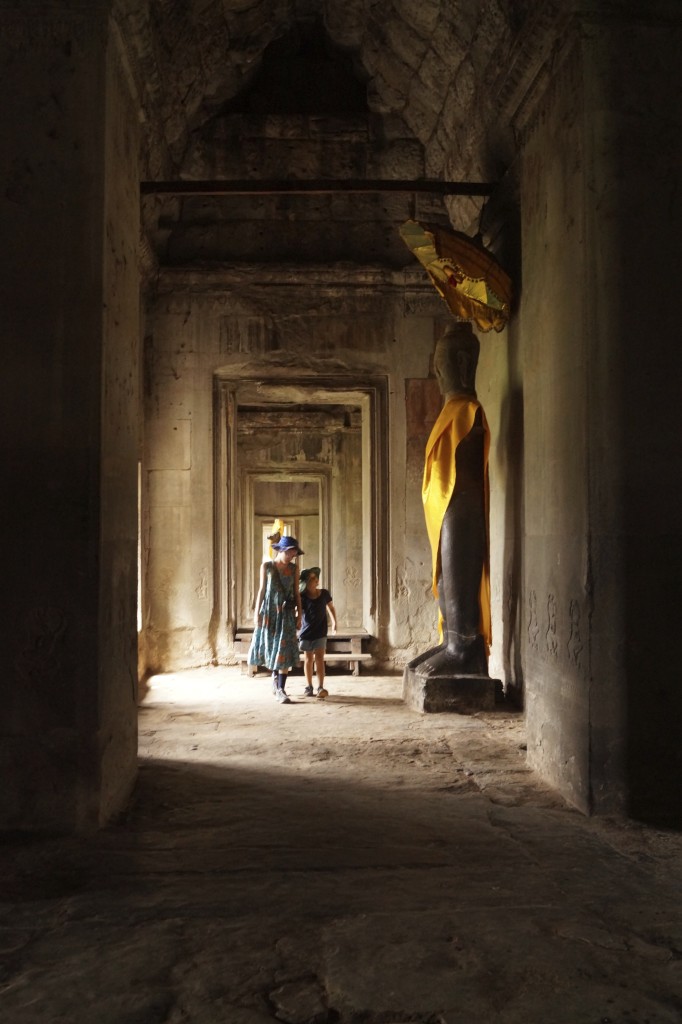
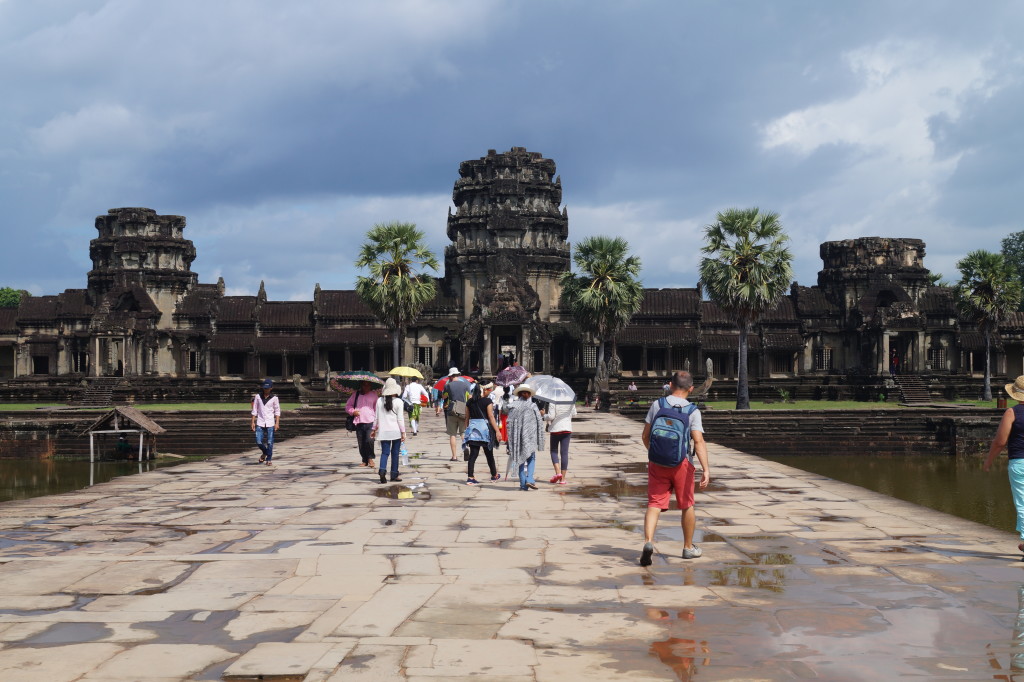
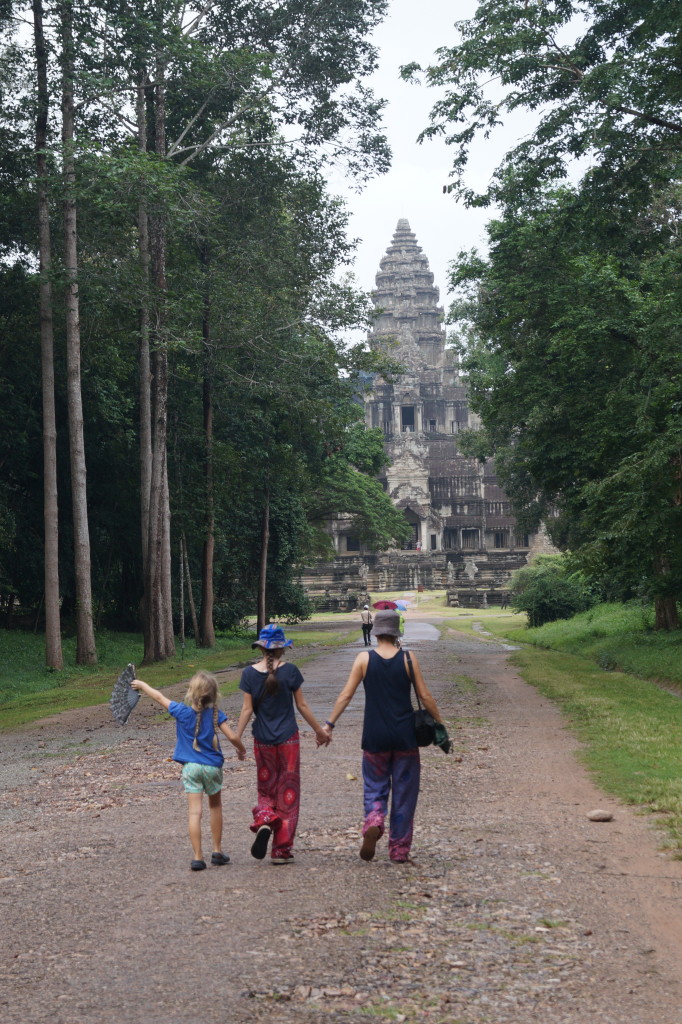
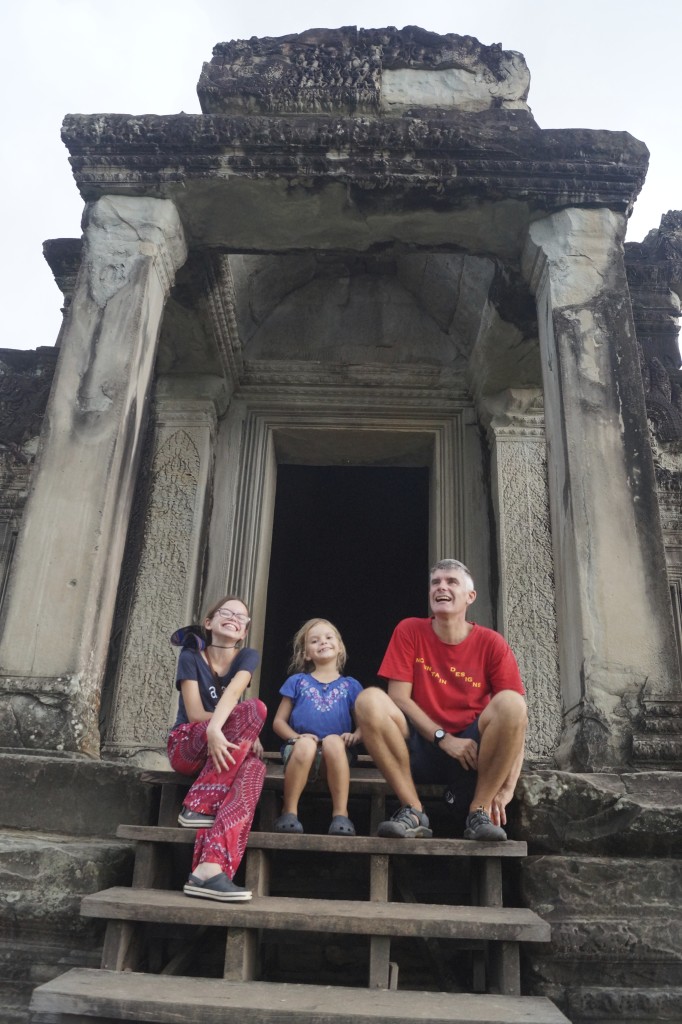
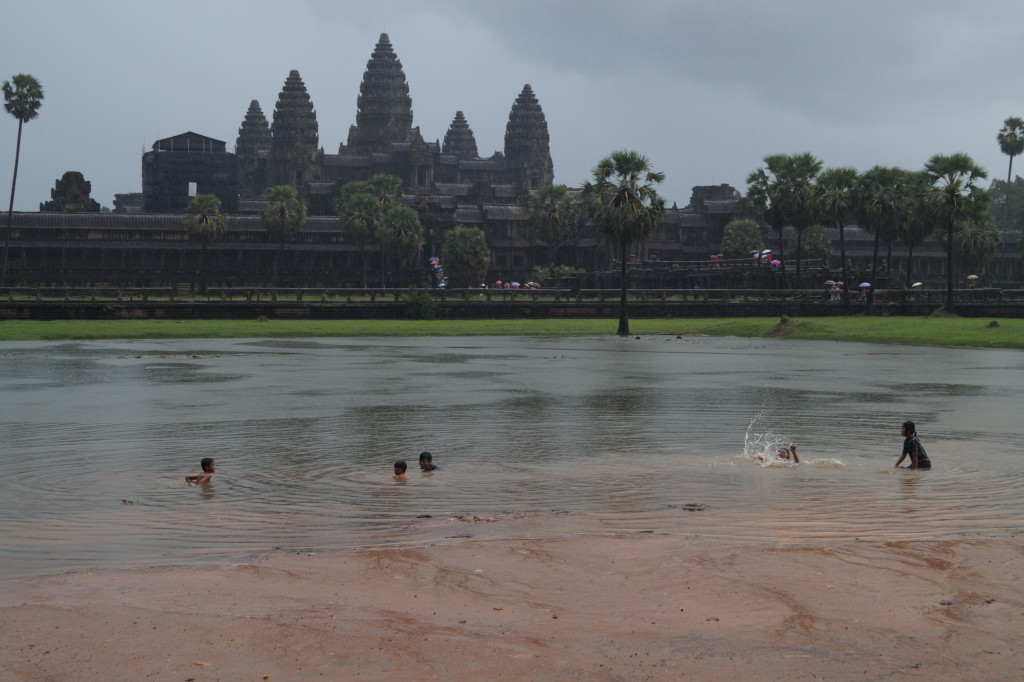
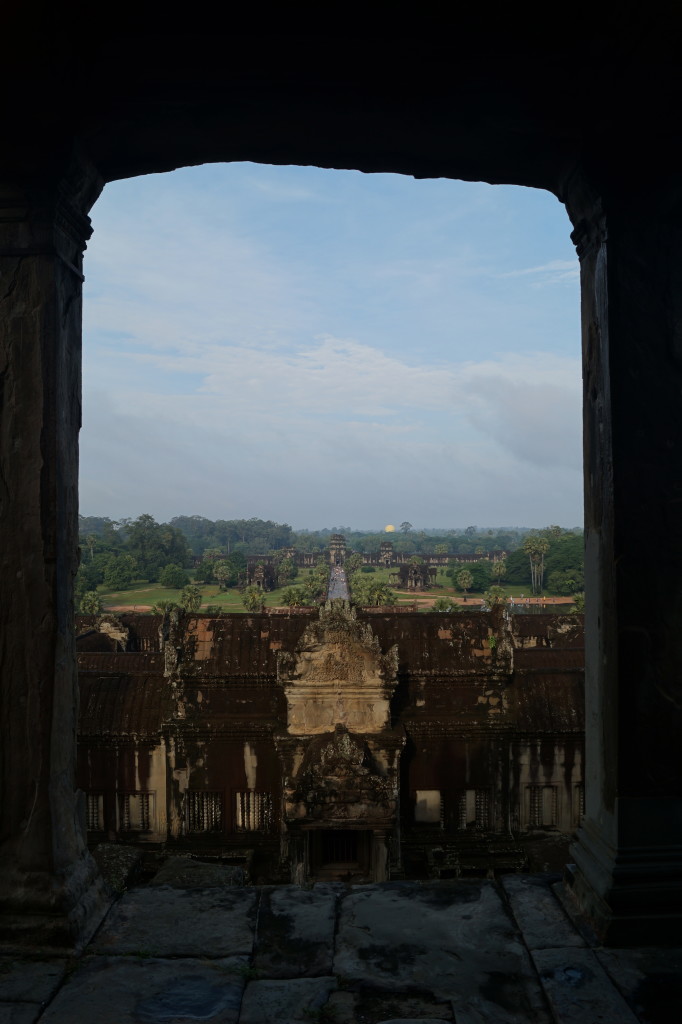
Ta Prohm's fame comes from the atmospheric beauty of its overgrown ruins. Muscular roots of jungle trees cover the crumbling towers, it's hard to tell if the trees are slowly strangling the temples or actually holding them up. The lush ferns, dripping mosses and mint green lichens all stood out on the black rain soaked stones. As we darted our from between cover it was hard to tell whether we were dripping with the regular precipitation or constant perspiration.
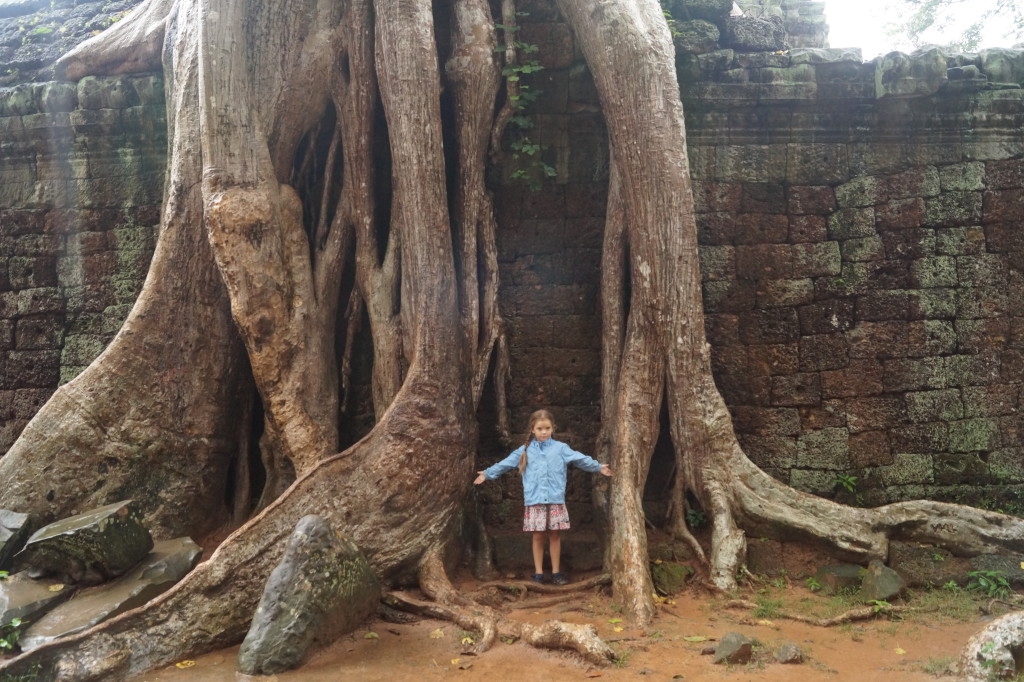
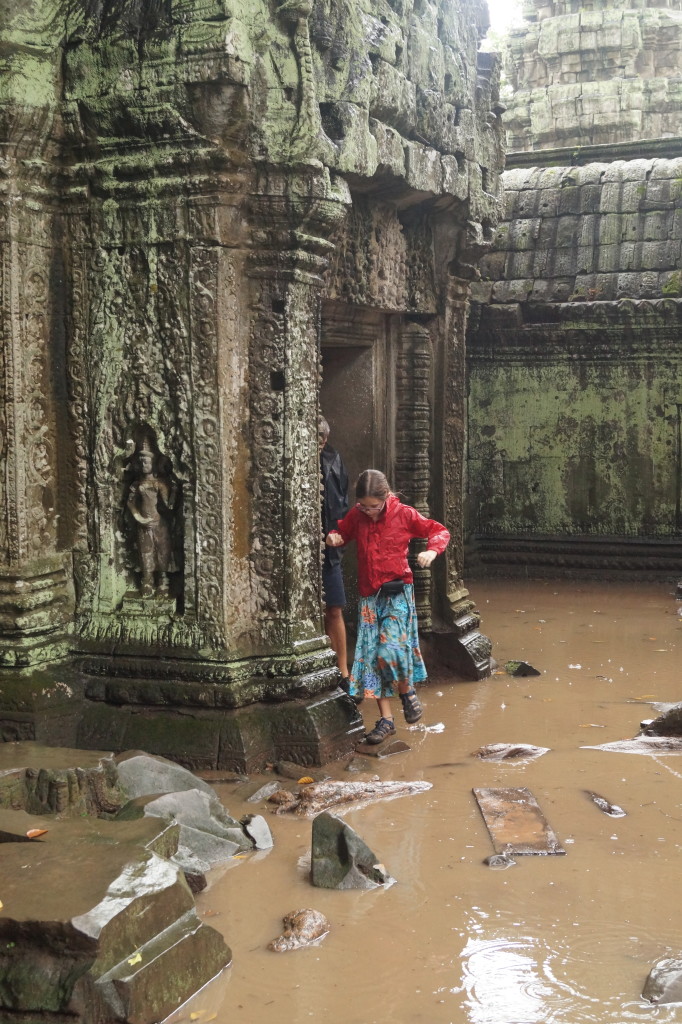
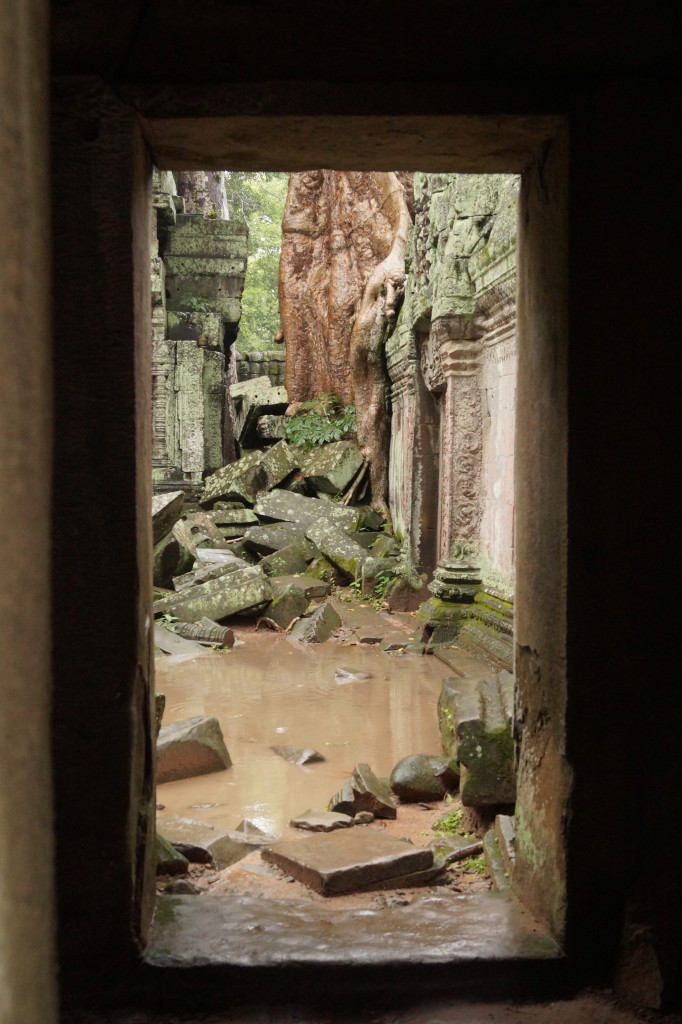
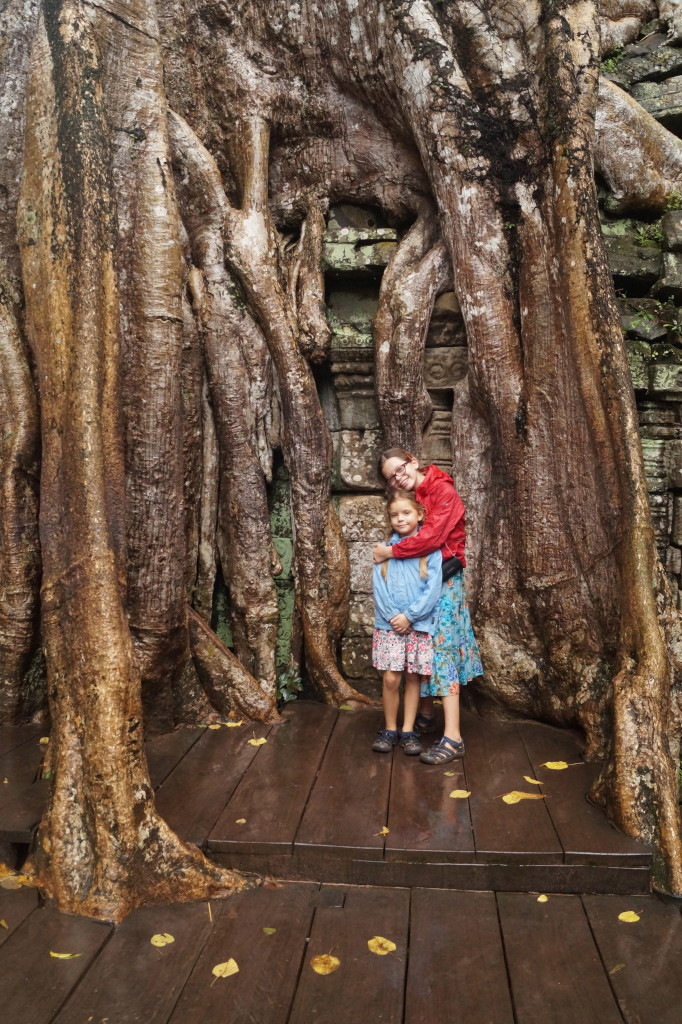
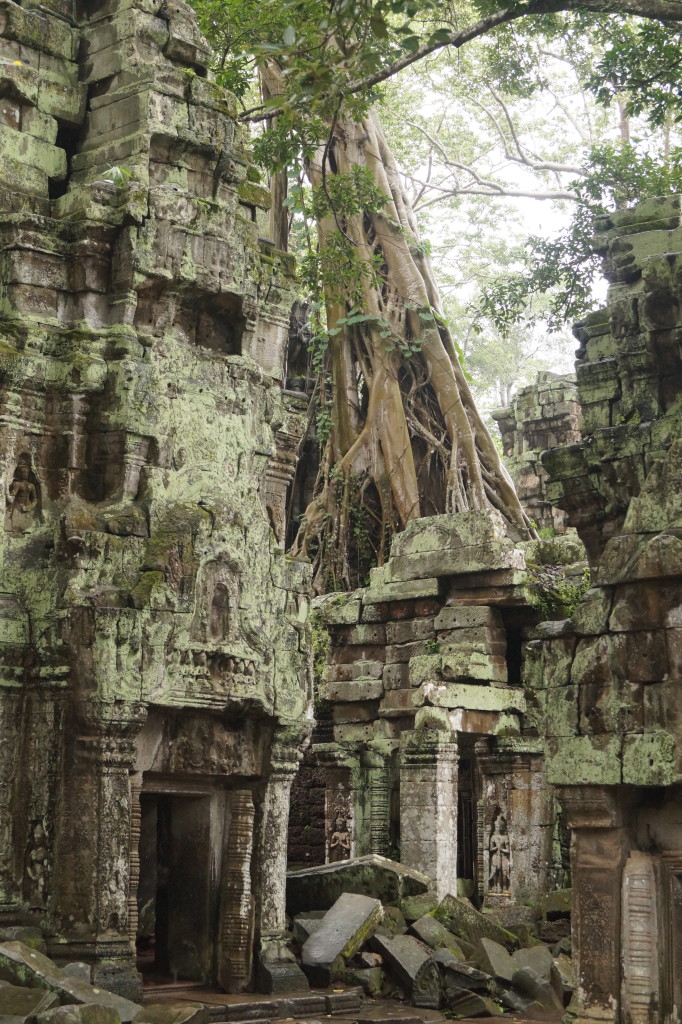
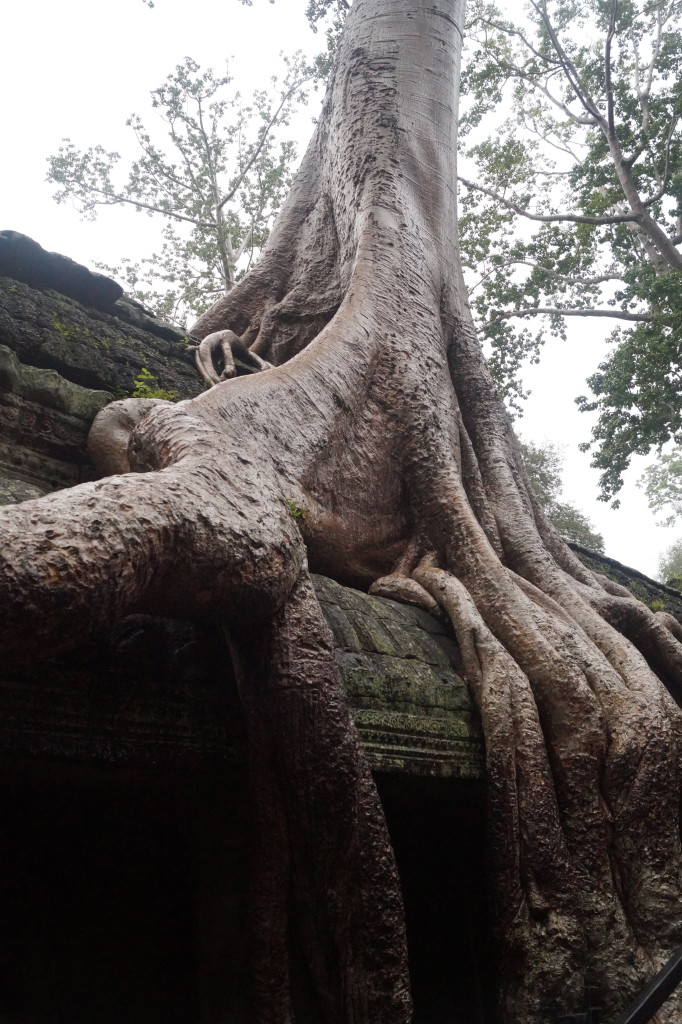
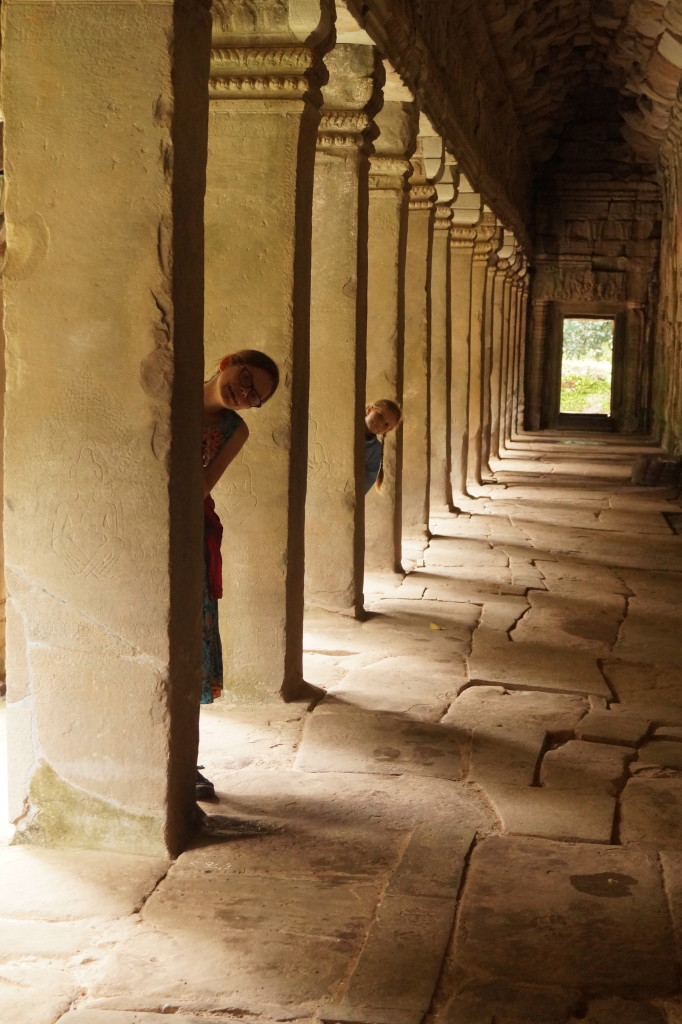
Of all the temples, my absolute favourite is Bayon inside the magnificent walled city of Angkor Thom. Just entering one of the cities four gates with its 54 demons and 54 gods having a tug of war with a seven-headed Naga snake on either side of the moat's bridge then passing under the gate covered with 4 huge faces, gave me shivers of excitement. We took a tuk tuk early one morning into the 10 kilometre square city, after one of our grey sunrise attempts, as the truck is far too big to get under the gate houses. We climbed quickly up to the top of the temple to admire the 216 smiling faces of Bodisattva Avalokiteshvara and had the place almost to ourselves. It was almost mind bending to workout all the massive faces on the 54 gothic towers. Which way to look? What to photograph? How to take it all in? Amazing! As it got busier we made our way down to the outer galleries to admire the 1.2km of beautiful bas-relief carvings showing life in the 12th century Khmer Empire.
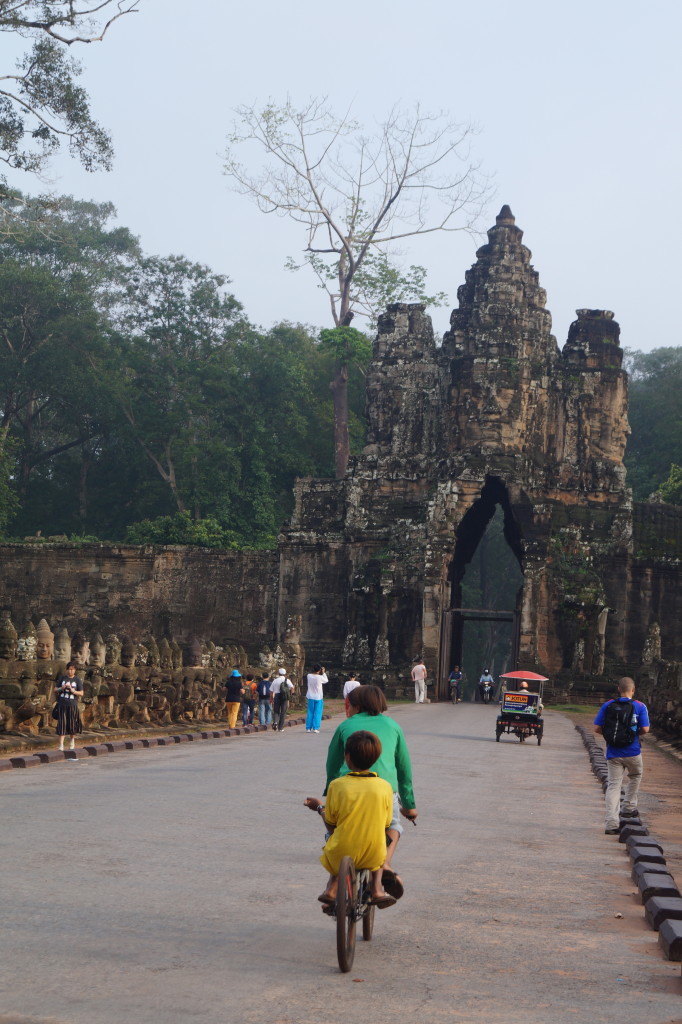
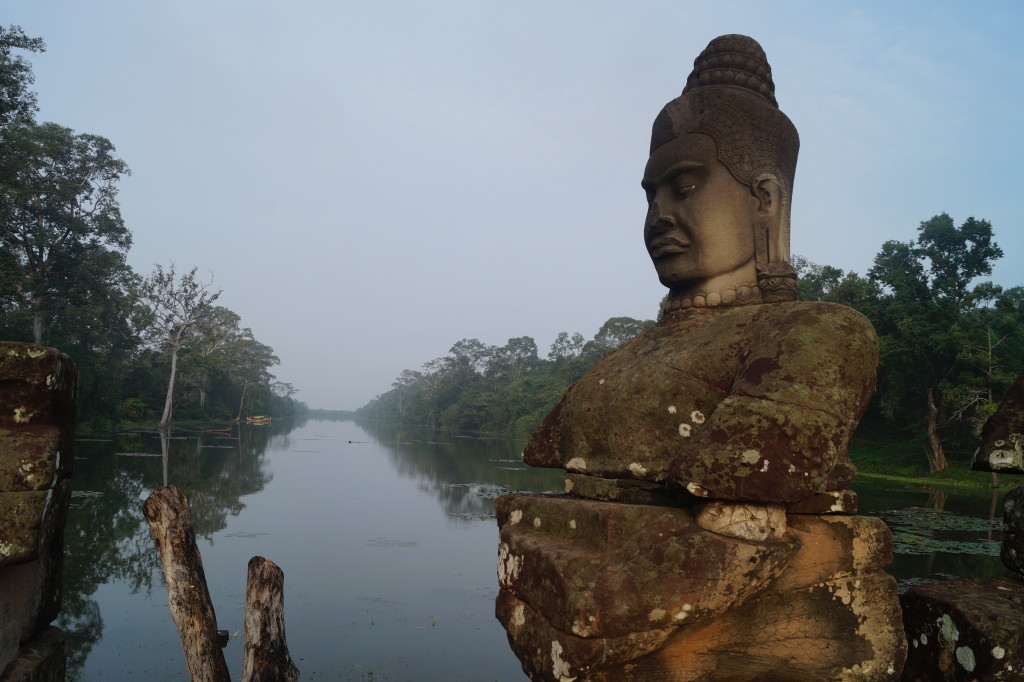
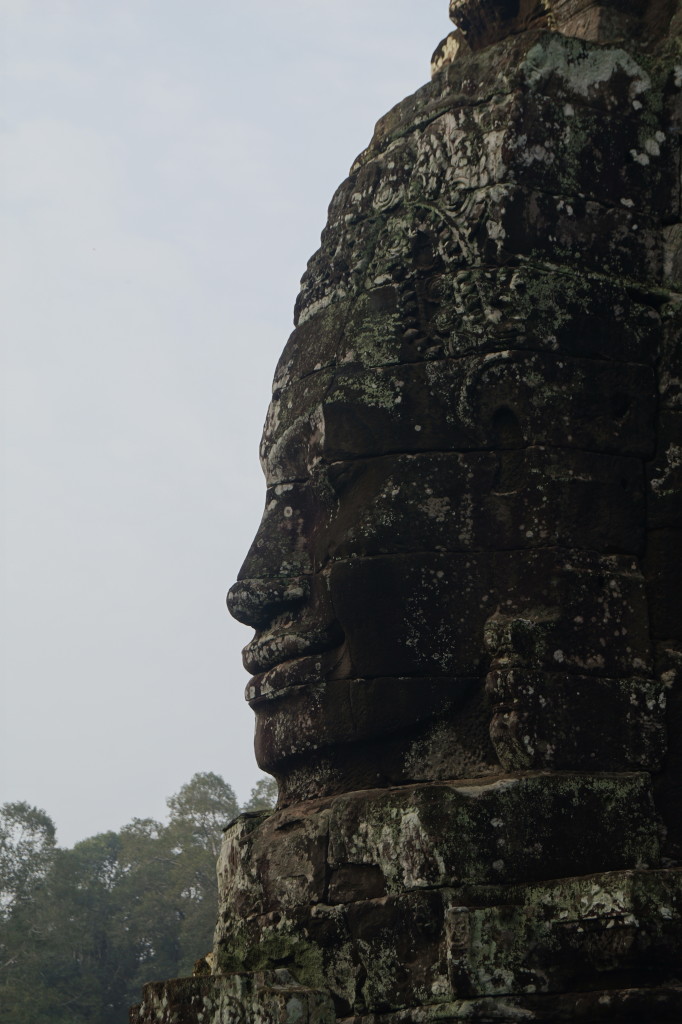
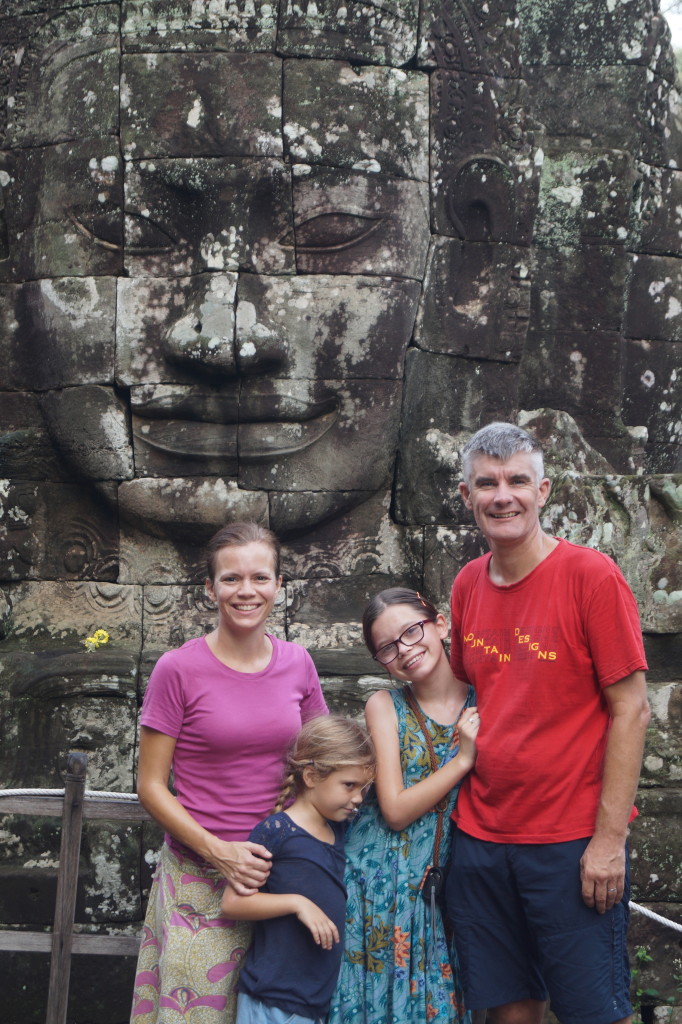
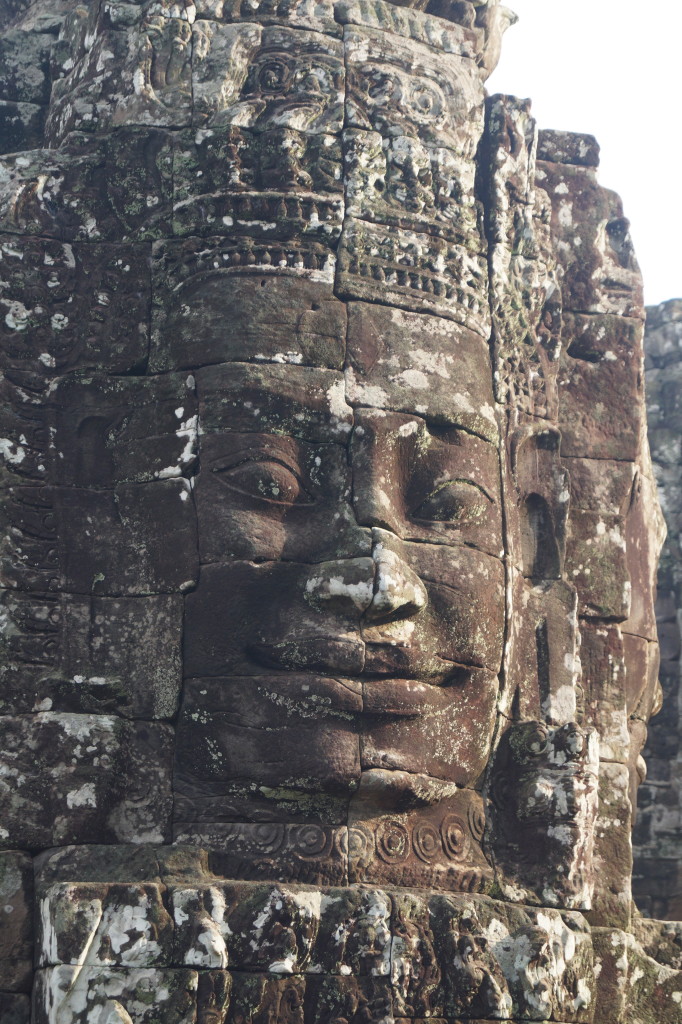
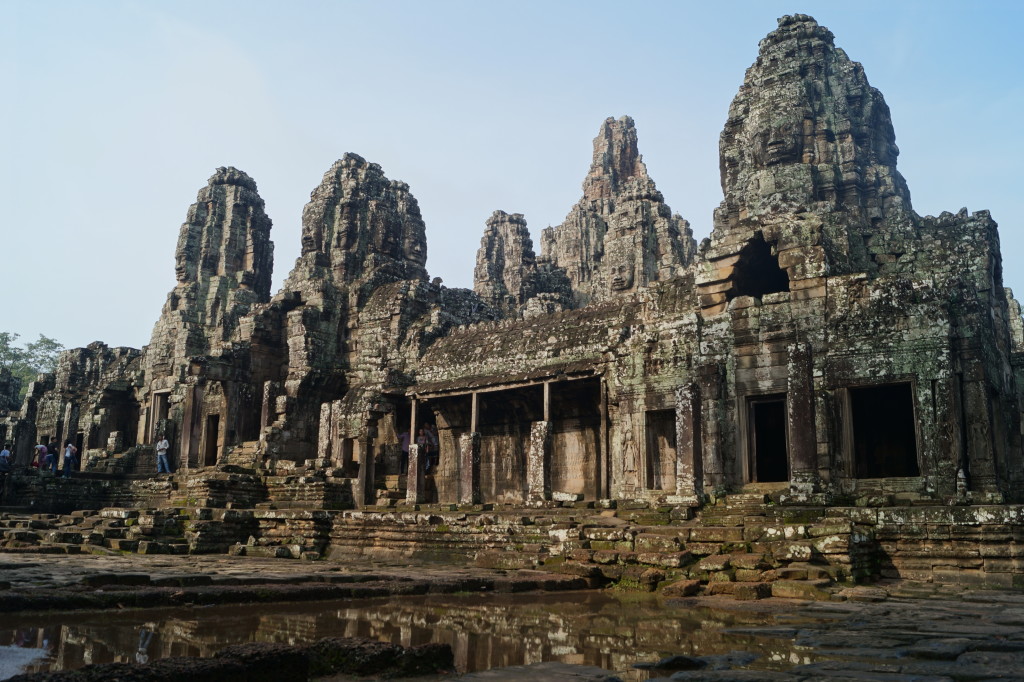
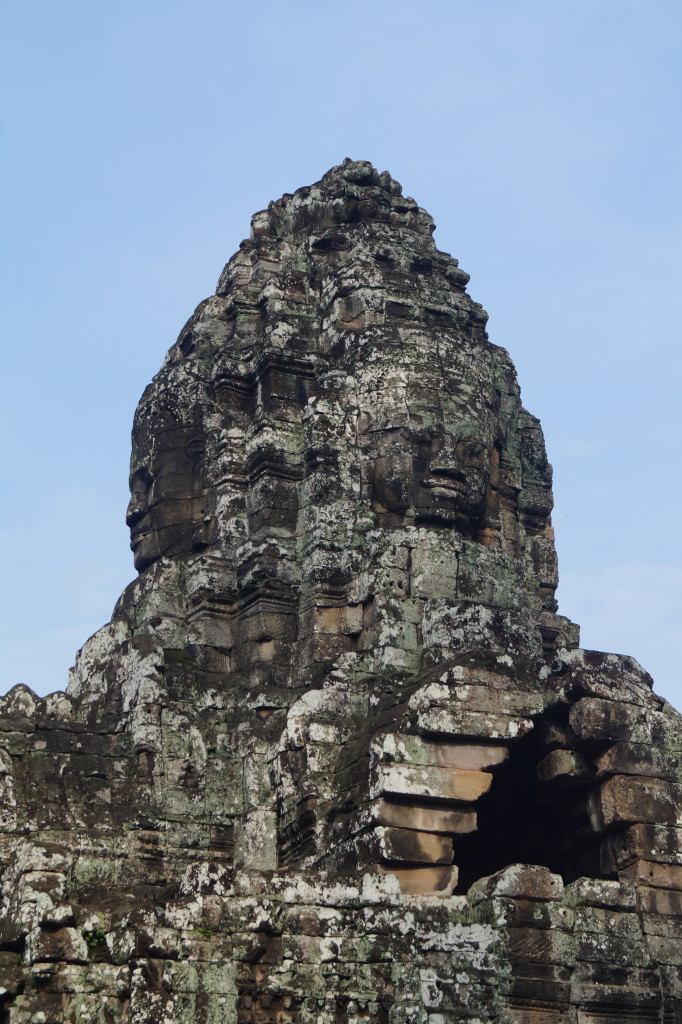
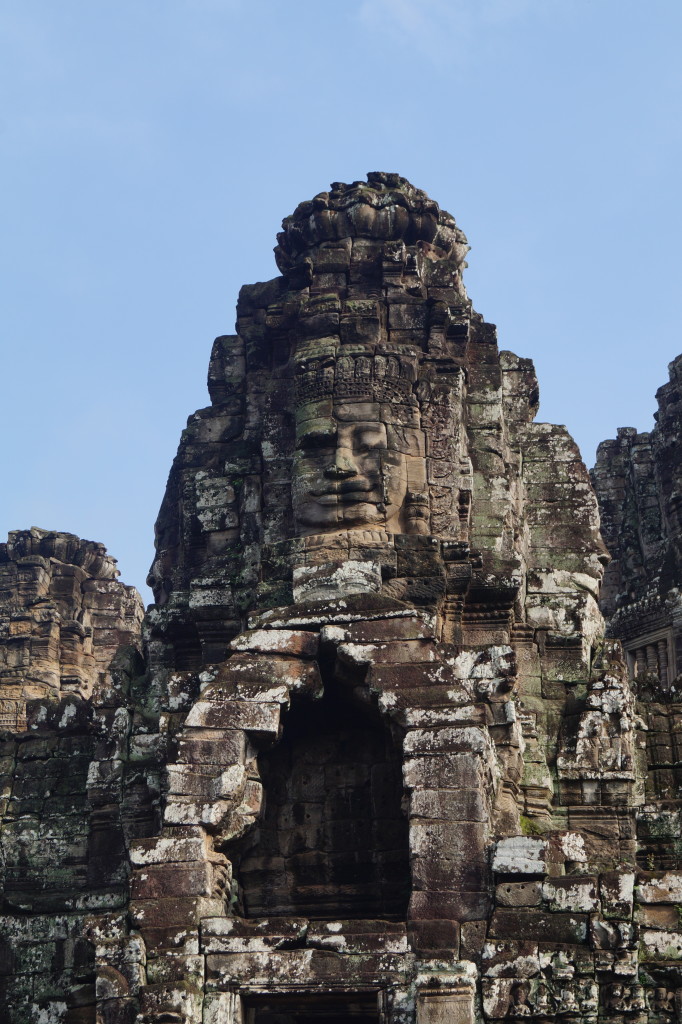
We spent the rest of the morning exploring the smaller temples of Angkor Thom, enjoying those falling apart choked in the jungle as much as the magnificent Terraces of the Elephants and the Leper King.
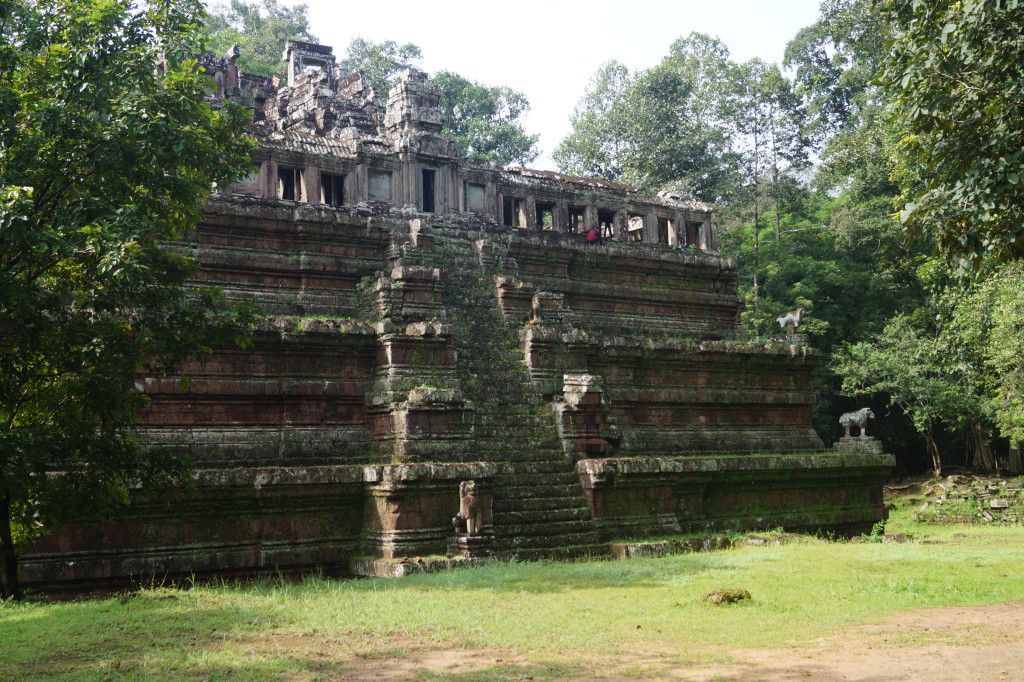
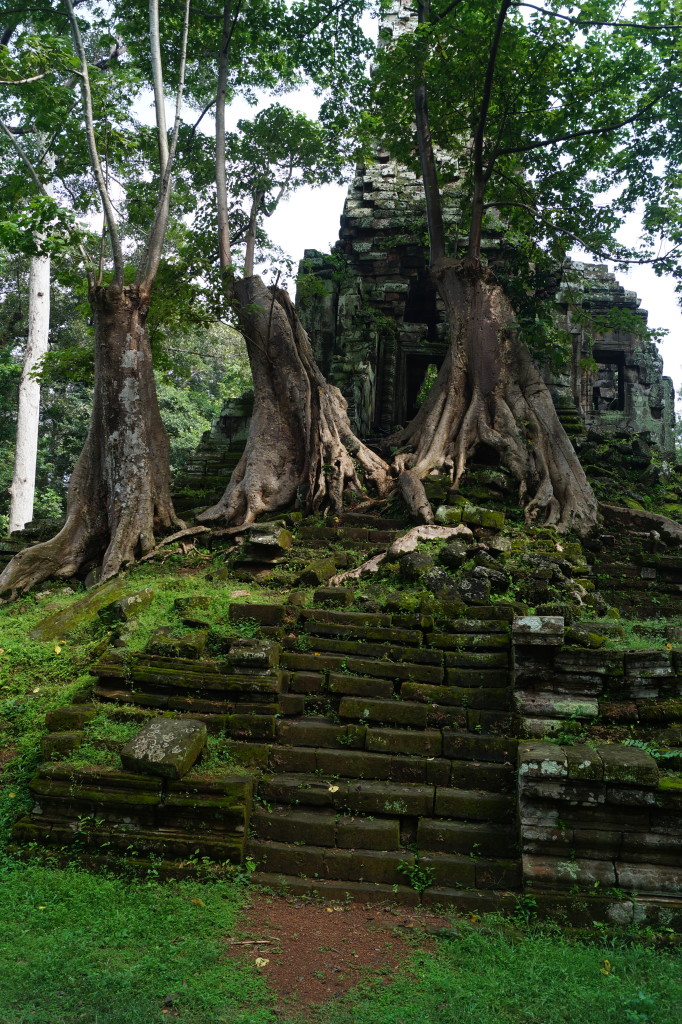
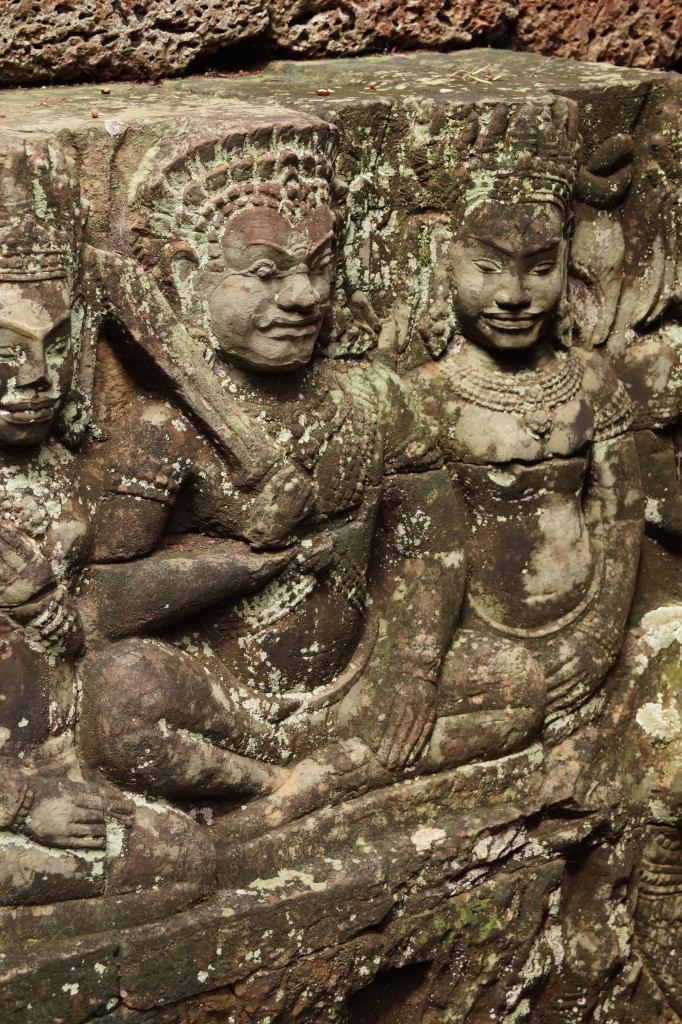
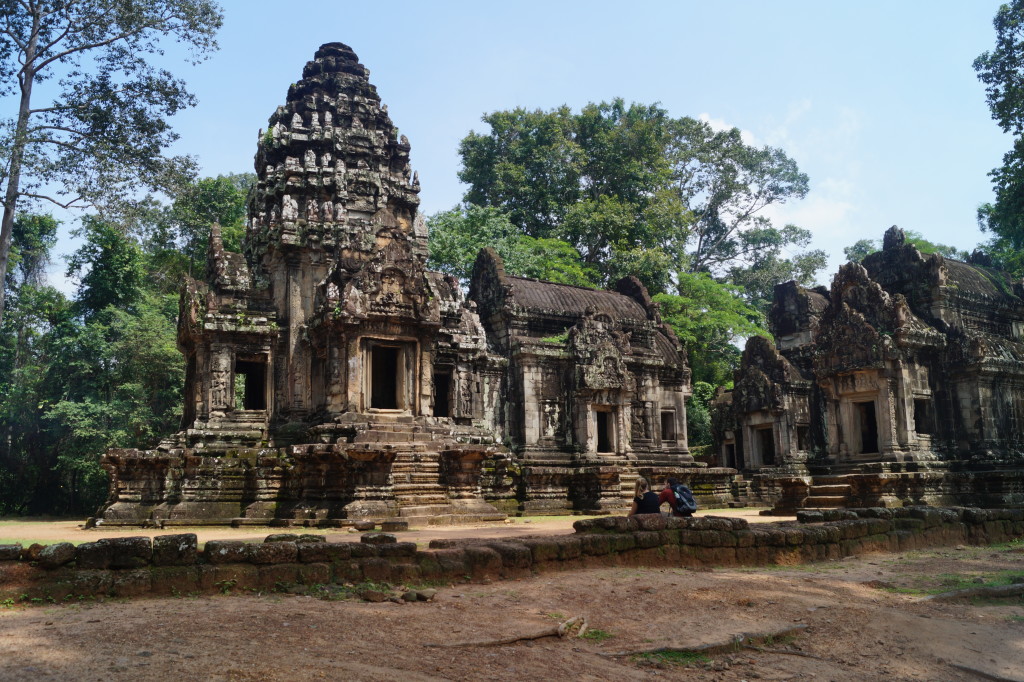
We really enjoyed taking our time to visit Angkor Wat and the surrounding temples, they really live up to the hype written about them. They truly are one of the "modern seven wonders of the world". Taking it slowly gave us a chance to appreciate them and avoid becoming "templed-out". We interspersed our cultural temple explorations with the delights of Siem Reap. Whilst it is a touristy town it's quite a fun place to be with lots of things to do and restaurants, which we enjoyed in the aptly named Pub Street.
 Arriving in the town of Siem Reap, all I wanted was to lie down in air-conditioning. Siem Reap is a few kilometres from the amazing UNESCO recognised ancient temples of Angkor Wat. Stretched out over many kilometres, they are all that is left of the mighty Khmer Empire that ruled the region between 802-1432 AD. We had already decided to spend a week in the area checking out some of the less visited temples as well as those at Angkor Wat and Angkor Thom. This turned out to be a great plan as it gave us lots of time for us all to get over being poorly and for Lucy to celebrate her 8th birthday.
Lucy will have been travelling for over half her life once we get home and this is her 4th birthday on the road. She has celebrated on the Big Sur in California; watching Jaguars in the Pantanal in Brazil; high up in the mountains of Lesotho and now in Cambodia. To be honest when you are 8, ancient temples are only so interesting up to a point. What you are really interested in on your birthday is toys and cake, so we skipped the sightseeing, relaxed at the hotel while she played with her few new toys, then explored town finding some very fancy birthday cupcakes at a bakery that trains vulnerable young women.
Arriving in the town of Siem Reap, all I wanted was to lie down in air-conditioning. Siem Reap is a few kilometres from the amazing UNESCO recognised ancient temples of Angkor Wat. Stretched out over many kilometres, they are all that is left of the mighty Khmer Empire that ruled the region between 802-1432 AD. We had already decided to spend a week in the area checking out some of the less visited temples as well as those at Angkor Wat and Angkor Thom. This turned out to be a great plan as it gave us lots of time for us all to get over being poorly and for Lucy to celebrate her 8th birthday.
Lucy will have been travelling for over half her life once we get home and this is her 4th birthday on the road. She has celebrated on the Big Sur in California; watching Jaguars in the Pantanal in Brazil; high up in the mountains of Lesotho and now in Cambodia. To be honest when you are 8, ancient temples are only so interesting up to a point. What you are really interested in on your birthday is toys and cake, so we skipped the sightseeing, relaxed at the hotel while she played with her few new toys, then explored town finding some very fancy birthday cupcakes at a bakery that trains vulnerable young women.
 We started our temple exploration at some of the further out sites building up to the more famous ones. Jungles are wet dripping places, earthy smelling and greenly fecund. You can still see the evidence of how the jungle hid the temples for many centuries with huge buttress rooted trees balancing precariously on top of temple roofs and long sinuous roots twisting around green mossy walls, like boa constrictors. Many of the temples have been cleared of the worst of the jungle, keeping the foliage at bay is the task for green-clad workers armed only with old fashioned scythes. We explored the maze of tall stupas, tumbled down walkways covered in mosses and lichens; exquisitely carved prayer halls and dark tunnels smelling of the heady mixture of incense and bats. There was a beautiful gem in almost every corner, just begging to be photographed. The girls had studied the different carvings of creatures from Hindu and Buddhist mythology earlier in school. So while Steve and I played "Indiana Jones" imagining ourselves hacking our way through the jungle, the girls called out: Apsara - heavenly nymph; Rishi - Hindu holy man, seven headed Naga snake; Kala - temple guardian who ate his own body ..... Bingo!
We started our temple exploration at some of the further out sites building up to the more famous ones. Jungles are wet dripping places, earthy smelling and greenly fecund. You can still see the evidence of how the jungle hid the temples for many centuries with huge buttress rooted trees balancing precariously on top of temple roofs and long sinuous roots twisting around green mossy walls, like boa constrictors. Many of the temples have been cleared of the worst of the jungle, keeping the foliage at bay is the task for green-clad workers armed only with old fashioned scythes. We explored the maze of tall stupas, tumbled down walkways covered in mosses and lichens; exquisitely carved prayer halls and dark tunnels smelling of the heady mixture of incense and bats. There was a beautiful gem in almost every corner, just begging to be photographed. The girls had studied the different carvings of creatures from Hindu and Buddhist mythology earlier in school. So while Steve and I played "Indiana Jones" imagining ourselves hacking our way through the jungle, the girls called out: Apsara - heavenly nymph; Rishi - Hindu holy man, seven headed Naga snake; Kala - temple guardian who ate his own body ..... Bingo!









 Not wanting to be thought of as "soft" hotel dwellers for too long we moved back to the truck for a few nights. The accommodating Tourist Police on the road out to the temple allow overlanders to park at their station, to discourage people from staying outside the temples. Unfortunately we were too tall to fit under their entry gate, "Don't worry," they said just park outside in the disused ticket office lay-by. Perfect we though, it might be a carpark but it was quiet and the concrete underneath was solid. There had been lots of torrential monsoon-type deluges during our time in Siem Reap and the ground was sodden, we had seen several vehicles stuck in up to their axles in mud, so we were keen to stay on the tar. So we sat smugly inside that night listening to the frogs sing and the rain thundering down, enjoying the slight dip in temperature.
After one of the rainstorms when we were parked at the hotel.
Not wanting to be thought of as "soft" hotel dwellers for too long we moved back to the truck for a few nights. The accommodating Tourist Police on the road out to the temple allow overlanders to park at their station, to discourage people from staying outside the temples. Unfortunately we were too tall to fit under their entry gate, "Don't worry," they said just park outside in the disused ticket office lay-by. Perfect we though, it might be a carpark but it was quiet and the concrete underneath was solid. There had been lots of torrential monsoon-type deluges during our time in Siem Reap and the ground was sodden, we had seen several vehicles stuck in up to their axles in mud, so we were keen to stay on the tar. So we sat smugly inside that night listening to the frogs sing and the rain thundering down, enjoying the slight dip in temperature.
After one of the rainstorms when we were parked at the hotel.
 It was just after 4.30am when we heard the first roar of an overworked tuk tuk engine, whizzing past a metre from the back of the truck's open windows. Like the sound of the annoying mosquito, I only partially gained consciousness rolled over and went back to sleep. Then the noise came again and again and again until I couldn't ignore it anymore, just what was going on outside. Looking out we realised that although the ticket office was no longer being used, every single vehicle visiting the temples had to pass through the lay-by to get their ticket checked. Maybe not such a great parking spot after all. Sod it, if you can't beat them- join them, was the decision. So up we got to drive the 5km to Angkor Wat to hopefully see the sunrise over the magnificent rooftop. Although the road was quiet by Cambodian standards and dead straight, driving in the pitch black was a challenge. Tuk tuks without lights whizzed in and out of potholes; we nearly ran into the back of a tractor and crazy backpackers doing stupid things on motorbikes and bikes. My least favourite was when we came across 4 bicycles holding onto the back of a motorbike taking up the whole of the road, none of which had any lights. It's no wonder there is a huge international hospital, as well as the local ones in Siem Reap.
Once safely at Angkor, having successfully not killed anyone else or ourselves on the road, we headed into the temple complex to watch sunrise. A pinnacle of many people's trip to South-East Asia, watching the soft morning glow of the sun rising above the spires of Angkor as the myriad of colours are reflected in the symmetrical pools is magical. Or not in this case. The rainy seasons omnipresent clouds meant that we watched a very grey looking Angkor Wat, slowly get lighter before it started drizzling. Oh well, there is always tomorrow. Off we set early again and three days after that - still no luck. We moved into a hotel for the intervening night, just so we could all have a lie in.
Using the camera's maximum "sunset" setting for sunrise over Angkor Wat.
It was just after 4.30am when we heard the first roar of an overworked tuk tuk engine, whizzing past a metre from the back of the truck's open windows. Like the sound of the annoying mosquito, I only partially gained consciousness rolled over and went back to sleep. Then the noise came again and again and again until I couldn't ignore it anymore, just what was going on outside. Looking out we realised that although the ticket office was no longer being used, every single vehicle visiting the temples had to pass through the lay-by to get their ticket checked. Maybe not such a great parking spot after all. Sod it, if you can't beat them- join them, was the decision. So up we got to drive the 5km to Angkor Wat to hopefully see the sunrise over the magnificent rooftop. Although the road was quiet by Cambodian standards and dead straight, driving in the pitch black was a challenge. Tuk tuks without lights whizzed in and out of potholes; we nearly ran into the back of a tractor and crazy backpackers doing stupid things on motorbikes and bikes. My least favourite was when we came across 4 bicycles holding onto the back of a motorbike taking up the whole of the road, none of which had any lights. It's no wonder there is a huge international hospital, as well as the local ones in Siem Reap.
Once safely at Angkor, having successfully not killed anyone else or ourselves on the road, we headed into the temple complex to watch sunrise. A pinnacle of many people's trip to South-East Asia, watching the soft morning glow of the sun rising above the spires of Angkor as the myriad of colours are reflected in the symmetrical pools is magical. Or not in this case. The rainy seasons omnipresent clouds meant that we watched a very grey looking Angkor Wat, slowly get lighter before it started drizzling. Oh well, there is always tomorrow. Off we set early again and three days after that - still no luck. We moved into a hotel for the intervening night, just so we could all have a lie in.
Using the camera's maximum "sunset" setting for sunrise over Angkor Wat.
 Despite our damp slight disappointment of the mornings, we loved the beauty of the main temple of Angkor Wat. The outside chambers are covered in exquisitely complex carved frescos, telling of epic battles and stories. The temples inside gradually get higher and higher and now you can climb up inside the highest spire to look out on the green paddy fields and jungle around you. It's a magical place. We went back a few times during the days to explore the further corners of the world's largest religious building.
Despite our damp slight disappointment of the mornings, we loved the beauty of the main temple of Angkor Wat. The outside chambers are covered in exquisitely complex carved frescos, telling of epic battles and stories. The temples inside gradually get higher and higher and now you can climb up inside the highest spire to look out on the green paddy fields and jungle around you. It's a magical place. We went back a few times during the days to explore the further corners of the world's largest religious building.






 Ta Prohm's fame comes from the atmospheric beauty of its overgrown ruins. Muscular roots of jungle trees cover the crumbling towers, it's hard to tell if the trees are slowly strangling the temples or actually holding them up. The lush ferns, dripping mosses and mint green lichens all stood out on the black rain soaked stones. As we darted our from between cover it was hard to tell whether we were dripping with the regular precipitation or constant perspiration.
Ta Prohm's fame comes from the atmospheric beauty of its overgrown ruins. Muscular roots of jungle trees cover the crumbling towers, it's hard to tell if the trees are slowly strangling the temples or actually holding them up. The lush ferns, dripping mosses and mint green lichens all stood out on the black rain soaked stones. As we darted our from between cover it was hard to tell whether we were dripping with the regular precipitation or constant perspiration. 





 Of all the temples, my absolute favourite is Bayon inside the magnificent walled city of Angkor Thom. Just entering one of the cities four gates with its 54 demons and 54 gods having a tug of war with a seven-headed Naga snake on either side of the moat's bridge then passing under the gate covered with 4 huge faces, gave me shivers of excitement. We took a tuk tuk early one morning into the 10 kilometre square city, after one of our grey sunrise attempts, as the truck is far too big to get under the gate houses. We climbed quickly up to the top of the temple to admire the 216 smiling faces of Bodisattva Avalokiteshvara and had the place almost to ourselves. It was almost mind bending to workout all the massive faces on the 54 gothic towers. Which way to look? What to photograph? How to take it all in? Amazing! As it got busier we made our way down to the outer galleries to admire the 1.2km of beautiful bas-relief carvings showing life in the 12th century Khmer Empire.
Of all the temples, my absolute favourite is Bayon inside the magnificent walled city of Angkor Thom. Just entering one of the cities four gates with its 54 demons and 54 gods having a tug of war with a seven-headed Naga snake on either side of the moat's bridge then passing under the gate covered with 4 huge faces, gave me shivers of excitement. We took a tuk tuk early one morning into the 10 kilometre square city, after one of our grey sunrise attempts, as the truck is far too big to get under the gate houses. We climbed quickly up to the top of the temple to admire the 216 smiling faces of Bodisattva Avalokiteshvara and had the place almost to ourselves. It was almost mind bending to workout all the massive faces on the 54 gothic towers. Which way to look? What to photograph? How to take it all in? Amazing! As it got busier we made our way down to the outer galleries to admire the 1.2km of beautiful bas-relief carvings showing life in the 12th century Khmer Empire.







 We spent the rest of the morning exploring the smaller temples of Angkor Thom, enjoying those falling apart choked in the jungle as much as the magnificent Terraces of the Elephants and the Leper King.
We spent the rest of the morning exploring the smaller temples of Angkor Thom, enjoying those falling apart choked in the jungle as much as the magnificent Terraces of the Elephants and the Leper King.



 We really enjoyed taking our time to visit Angkor Wat and the surrounding temples, they really live up to the hype written about them. They truly are one of the "modern seven wonders of the world". Taking it slowly gave us a chance to appreciate them and avoid becoming "templed-out". We interspersed our cultural temple explorations with the delights of Siem Reap. Whilst it is a touristy town it's quite a fun place to be with lots of things to do and restaurants, which we enjoyed in the aptly named Pub Street.
We really enjoyed taking our time to visit Angkor Wat and the surrounding temples, they really live up to the hype written about them. They truly are one of the "modern seven wonders of the world". Taking it slowly gave us a chance to appreciate them and avoid becoming "templed-out". We interspersed our cultural temple explorations with the delights of Siem Reap. Whilst it is a touristy town it's quite a fun place to be with lots of things to do and restaurants, which we enjoyed in the aptly named Pub Street. 
